#so much applicable freud knowledge
Explore tagged Tumblr posts
Text
Something Godfeels Something Freud Something Problem Sleuth Something Female Counterparts
I've cracked *something* here.
#Homestuck#problem sleuth#godfeels#vriska#trans vriska#june egbert#freud.intensifies#so much applicable freud knowledge#pancakestein said that#godfeels; or#i dreamed of feeling better#godfeels or i dreamed of feeling better
8 notes
·
View notes
Text
It's incredibly frustrating to me that in most conversations with pro/endos, they fail to accurately quote facts that are easily verified.
The DSM III didn't have a distress component - Easily verified as false
The ICD-10 doesn't include any description of MPD - Easily verified as false
Ross said this - Easily verified as... At least slightly misleading as presented
Freud didn't say that - Here's his book, have at it
MPD was in the ICD until 2019 - nope
Normal Dimensions of Multiple Personality Without Amnesia is proof of endogenics - Easily verified as flat out wrong and says no form of multiplicity is real
But the veteran-- Have you read the paper? Do you know what that doctor did? (hah DID)
Where they manage to win debates is in statements that are just unclear enough that it can't be easily verified in a simple, linear way, and where subjectivity comes into play.
Take, for example, the cultural exclusion. The DSM fails to accurately define what this means, and so it can be taken in a very broad, surface level way, or it can be taken to hold much more weight and reverence in its application (and as someone with a professional background in social services, I'm telling you, it's the second one).
As long as a pro/endo continues to point this fact out, it doesn't matter how much research you cite. You could have forty peer reviewed articles to their one (and it's not even an article, it's an interview with a tulpa). You could have access to all those articles and books hidden behind paywalls.
As long as they can find an equally subjective, weakly defined quote, the cycle continues. You present further research--mountains of it, now trying to prove a tangential point. You show instances of the author they quoted making a more definitive statement in another paper.
By the time you've hit this point, no one cares how much research there is or the sheer number of clinicians repeatedly saying the same things across multiple studies and papers.
The path from point A to point B has become distorted and now you're "reaching" to apply things and the original point is lost.
And all it takes is continuing to hold on to obscure statements that could potentially be taken the other way, if you ignore supporting evidence.
It is impossible to prove to them that what you're saying has merit-- not because you lack evidence, but because you can't disprove the uncertainty with a definitive enough statement.
These statements are so simple, so basic to the fundamentals of psychology, that you won't find anyone purposefully defining them in a way that will satisfy pro/endos.
Take, again, the cultural exclusion. Did you know that there's a section in the back of the DSM that gives examples of cultural forms of dissociation?
No.
Guaranteed you did not know that.
But it's there. None of the things described are remotely similar to the very recent trend of lonely white boys in America making pony tulpas in their teens (you can't come for me, that's practically a direct quote from your favorite tulpa author).
But my point is, we frequently overlook this obvious lack of knowledge of general psychology and essential basic resources.
We continually ignore that these corrections mean that they are not knowledgeable in what they're talking about.
But they look knowledgeable in other areas because you can't win against a subjective experience.
Hell, one of the most used sources being used, in every screencapture, follows the quote with "but this is disputed", and no one bats an eye.
But how can you properly judge what you're experiencing if you don't have even the basic knowledge needed to be interpreting the weakly defined concepts you're arguing for or against?
Most can't even accurately define trauma or dissociation and can't access proper articles, how can we be expected to blindly accept their judgement?
I understand the whole, "no one knows you better than yourself." That is absolutely true and I fully support that statement (shocking, I know). My issue comes from the fact that there is an obvious and clear lack of knowledge on the language and concepts surrounding their experiences.
Yes, absolutely, you are experiencing this thing, I believe you and I support you.
But I also see the statements that are so off the mark that I can't, in good conscious, believe your own unsubstantiated theories about how and why it's happening, and the only language you have to use is twisted versions of another concept entirely.
Now, when I say that, I'm talking about things like gateway systems and walk ins and walk outs, the supernatural being introduced to the same discussions as DID and OSDD.
Or of being born plural, where the TOSD briefly describes the unintegrated sense of self that all children have and the definition of "trauma" is so incredibly misunderstood, and how symptoms of other disorders can subjectively feel like the symptoms of another, but no one wants to hear that, or about the harm that incorrect treatments based on biased, uneducated self reporting can cause.
And it goes on and on, repeating on a loop.
And we just keep ignoring that they can't even get basic facts right.
47 notes
·
View notes
Text
Reparative Reading
I would love, and indeed have been meaning for a long time, to talk about a piece of academic writing from one of my favourite theorists that I think has an ongoing relevance. This is Eve Kosofsky Sedgwick’s “Paranoid Reading and Reparative Reading,” first published in the mid-to-late 1990’s and compiled in her 2003 monograph, Touching Feeling. There’s a some free PDFs of it floating around (such as here) for those who want to read it in full – and I would recommend doing so, despite its density in places, because Sedgwick has a marvelous critical voice.
Sedgwick’s topic of contention in this essay is the overwhelming tendency in queer criticism to employ what she thinks of as a paranoid methodology – that is, criticism based around the revelation of oppressive attitudes, and that sees that revelation not only as always and inherently a radical project, but the only possible anti-oppressive project. This methodology is closely related to what Paul Ricoeur termed the “hermeneutics of suspicion” and identified as central to the works of Marx, Nietzsche, and Freud, which were all progenitors of queer criticism. Sedgwick objects to the fact that the hermeneutics of suspicion had, at her time of writing, become “synonymous with criticism itself,” rather than merely one possible critical approach. She questions the universal utility of the dramatic unveiling of the presence of oppressive forces, pointing to the function of visibility itself in perpetuating systemic violence, and identifying the work of anti-oppression as one based in a competition for a certain type of visibility. She also rejects the knowledge of the presence of oppression alone as conferring a particular critical imperative, instead posing the question, “what does knowledge do?”
As an example, Sedgwick critiques Judith Butler’s commentary on drag in Gender Trouble, one of the works that she uses as an example of a reading based in a paranoid approach. She identifies Butler’s argument that drag foregrounds the constructed aspect of gender as a paranoid approach, due to its focus on revelation of structures of power and oppression, and she finds Butler’s argument lacking in its neglect in acknowledging the role that joy and community formation play in the phenomenon of drag. Near the end of the essay, she also does an example of a reparative reading of the ending of Proust’s In Search of Lost Time, claiming that the narrator’s remove from the traditional familial structure and its temporality is precisely what confers his particular moment joy and insight upon discovering that his friends have aged. Broadly, Sedgwick rejects the implication that readings based in joy, hope, or optimism are naïve, uncritical, or functionally a denial of the reality of oppression.
Now, it’s important to note that the message of this essay is not that paranoid readings are bad, and reparative readings are good. Sedgwick is drawing on a body of affect theories (most prominently Melanie Klein’s) that posit the reparative impulse as dependent on and resulting from the paranoid impulse – reparation by definition is something that can only occur after some kind of shattering, and Kleinian trauma theories generally posit that process as something that produces a new object or perspective than pre-trauma. (Something I love about Sedgwick is that she often sets up these binaries that seem at odds with each other, but end up being mutually dependent.) Furthermore, the critical tradition in queer studies that Sedgwick is critiquing in this essay is one that was itself, in many ways, a manifestation of communal trauma, particularly with the impact of the AIDS crisis. Sedgwick herself acknowledged this last point in a later essay, “Melanie Klein and the Difference Affect Makes,” claiming that she didn’t feel she did a good enough job of identifying the AIDS crisis as a driving force behind this trend. So Sedgwick is not discounting the utility of paranoid readings, but rather rejecting the notion that they ought to encompass all of criticism. (In fact, a running theme in Touching Feeling is her representation of various perspectives and methods as sitting beside one another, rather than hierarchically.) And reparative reading, as Sedgwick portrays it, is not the denial of trauma or violence, but a possibility for moving forward in its wake.
Why am I taking the time to outline all of this? Because, while the original essay was written almost 25 years ago, with the academic community in mind, it reflects a similar pattern that I see now in online fandom.
Queer fandom (as that’s what I feel the most qualified to talk about) has a considerable paranoia problem. Queer fandom is brimming with traumatized people who carry varying degrees of personal baggage and are afflicted by the general neuroses that come from existing in a heterosexist, cissexist society. And many people in fandom have been repeatedly burned by the treatment of queer people in media – Bury Your Gays, queerbaiting, queercoded villains, etc. And in such a media landscape, and within such a communal sphere, much of fandom has developed the kind of “anticipatory and reactive” method of media criticism that Sedgwick identifies in this essay.
Fandom gets very excited for new media, certainly, and is prone to adulation of media that seems to fit its ideological beliefs. But it is also very quick to hone in on any potential representative flaw, and use that as a vehicle for condemnation. (This cycling between idealization and extreme, bitter jadedness has been widely commented on). Not only is there a widespread moralistic approach in fan criticism that is very invested in deeming whether or not a piece of media is harmful or not, “problematic” or not, within a simplistic binary framing, but that conclusion is so frequently the end of the conversation. “This is problematic,” “this is bad representation,” “this falls into this tired and harmful trope,” etc, is treated as the endpoint of criticism, rather than a starting point. This is the spectacle of exposure that Sedgwick critiques as central to the paranoid approach – simply identifying the presence of oppressive attitudes in a text is not only treated as an analytic in and of itself, but as the only valid analytic. So often I have seen people jump to take the most pessimistic possible approach to a piece of media, and then proceed to treat any disagreement with that reading as in and of itself a denial of structural homophobia, as naïve, and as not being a critical enough reader/viewer. “Being critical” itself has been taken on as a shorthand for this particular process, which many others have commented on as well.
Now, again, I want to stress that taking issue with this totalizing impulse is not discounting the legitimate uses of identification and exposure, or even of reactivity and condemnation. There are particular contexts in which these responses have their uses – in Sedgwick’s words, “paranoia knows some things well and others poorly.” But that approach has a finite scope. And rejecting the universal application of this particular analytic does not itself constitute a denial of the existence of oppression, or its manifestation in media and narratives. Nor is it about letting particular works “off the hook” for whatever aspects they may have that are worthy of critique. Rather, it’s a call to acknowledge that other critical approaches exist, and that the employment of a more optimistic approach is not necessarily a result of ignorance or apathy about the existence of oppression. It is one that invites us not to lay aside paranoia as an approach, but recognize that it has limited applicability, and question when and how our motives might be better served by another approach.
I think that “is this homophobic, yes or no?” or “is this good representation, yes or no?” are reductive critical approaches in and of themselves. But I think there’s also room for acknowledgment that not everything needs to be read through a revelatory lens regarding societal oppression at all. Rather than “what societal attitudes does this reflect back?” being the approach, I think there could be a good bit more “What does this do for us? What avenues of possibility does this have?” I think there’s already been leanings in this direction with, for example, the reclaiming of queercoded villains, with dialogues that treat those characters not as reflections of societal anxiety and prejudice, but rather as representative of joy and freedom and possibility in their rejection of norms and constraints. I’d like to see that approach applied more broadly and more often.
Let’s try to read more reparatively.
#alpha speaks#alpha's literary opinions#eve sedgwick#literary criticism#queer studies#help me sedgwick#also apparently 'reparatively' isn't actually a word but sedgwick invented words in a similar way all the time so#lord i hope this is all coherent...#these concepts are always more complicated and harder to convey than they seem#my meta#big sigh.#queue#for pillowfort#(when it comes back online)
225 notes
·
View notes
Text
"It is a long superseded idea, and one derived from superficial appearances, that the patient suffers from a sort of ignorance, and that if one removes this ignorance by giving him information (about the causal connection of his illness with his life, about his experiences in childhood, and so on) he is bound to recover. The pathological factor is not his ignorance in itself, but the root of this ignorance in his inner resistances; it was they that first called this ignorance into being, and they still maintain it now. The task of the treatment lies in combating these resistances. Informing the patient of what he does not know because he has repressed it is only one of the necessary preliminaries to the treatment. If knowledge about the unconscious were as important for the patient as people inexperienced in psychoanalysis imagine, listening to lectures or reading books would be enough to cure him. Such measures, however, have as much influence on the symptoms of nervous illness as a distribution of menu-cards in a time of famine has upon hunger. The analogy goes even further than its immediate application; for informing the patient of his unconscious regularly results in an intensification of the conflict in him and an exacerbation of his troubles."
— Sigmund Freud, "'Wild' Psycho-Analysis" (1910)
1 note
·
View note
Text
Ceremonial Magic Some Secret Sources Of Energy
Many systems have been developed over the ages to help us control our thoughts. A great amount of dogma too has been kicked around in an attempt to make us into better people. Magick (the occult kind, spelled with a ‘k’) is one of the oldest and most general of these systems. Magick is the study and application of psychic forces. It uses mental training, concentration, and a system of symbols to program the mind. The purpose of magick is to alter the self and the environment according to the will.

Most of the magick we see today comes to us from ancient Egypt and Chaldea. The Chinese, Hindus, and Tibetans developed their own unique types of magick.
Western magick was locked up by the Egyptian priests for thousands of years and then suppressed by the rise of Christianity. It was not until medieval Europe that the alchemists and Cabalists rediscovered magical knowledge. Only during the past hundred years or so has western culture been open minded enough to permit widespread investigation of the subject. Only since the start of the twentieth century has science shown much interest in it al all.
Parapsychology and Psychic Phenomena
Through parapsychology, we are gaining insights into the hidden nature of man. Parapsychology is a branch of psychology, which studies psychic phenomena. It remains something of a frontier, even today. Perhaps one reason for this is that psychic phenomena are somewhat inconsistent. Nevertheless, there is strong evidence from numerous cases and experiments in support of psychic phenomena. Somehow, under the right conditions, the mind can directly affect the environment.
We may theorize that the human mind and body broadcasts a kind of psychic energy or force, much like a radio station. Kirlian photography, temperature effects, cloud chamber tests, and other experiments tend to support this theory. Although the exact nature of this psychic force is subtle and unknown, it is undoubtedly the energy behind all psychic phenomena and magick. However, it is not a radio wave, since it behaves somewhat differently. The psychic force is too weak to be measured directly (at least so far as we know). Everyone has some psychic ability. There are numerous types of psychic phenomena. Parapsychology separates them into two groups: ESP and PK.
What is ESP?
ESP, the abbreviation for extra sensory perception, means the reception of information through paranormal means (ie. not regular physical senses of sight, sound, touch, smell, or taste). In theory, this is accomplished by receiving psychic force from outside the body. Here are some examples of ESP:
Clairvoyance, or Remote Viewing — the ability to sense or ‘see’ (non-physically) distant objects, places, and people. Individuals who see ghosts and spirits are probably clairvoyant.
Clairaudience, or remote hearing — the ‘hearing’ of paranormal information.
Astral Projection (OOBE) or Travelling Clairvoyance — Full experience at a remote location while the physical body sleeps.
Psychometry — the reading of information by the touch of physical objects.
Telepathic receiver — the ability to directly receive thought (communication) at a distance, with no physical connection to the sender. There are many everyday examples of this, in which we think something just as another person is about to say it. This is an easy one to test for through experiment. Very dramatic cases of telepathy have been recorded; there is often an emotional element in such cases.
A ‘channel’ or medium, as in a science who is in direct communication with a ‘spirit’ or entity.
Experience with a Ouija board, pendulum, or automatic writing.
Precognition — to foresee the future. Again, highly emotional events are the ones most likely to be ‘tuned in’.
Retrocognition — knowledge of the past, by paranormal means.
What is PK?
PK, the abbreviation for psychokinesis, is the active or sending side of psychic phenomena. The theory here is that psychic force is sent out from the individual. Examples of PK include:
Telepathic sender — the transmitter in the telepathy just discussed.
Psychokinesis (or telekinesis) proper — the ability to move objects by means of psychic force.
Somewhat along the same lines are poltergeist (noisy ghost) phenomena in which objects move of their own accord or noises are heard. There is always a human agent involved — frequently a teenage girl — who appears to be the source of psychic energy.
Psychic healing — the ability to heal various illnesses and infirmities. There are many documented cases of this. Usually it involves a healer and a subject, although there are recent cases involving cancer patients learning to heal themselves.
Teleportation, asportation, and levitation.
Some occultists feel a magician producing PK effects is simply a channel for universal energy. Others think the force originates some way directly within the magician.
The Subconscious
Postulated by Freud and others, the concept of the subconscious mind is an important one. Basically, this is the idea that part of the mind normally operates below or outside of ordinary consciousness and awareness. Dreams and hypnosis are examples of this. Also subconscious are the many automatic functions of the physical body such as respiration and digestion
#embraceyourself#holistichealth#magicalmoments#positiveaffirmations#spiritualbeings#manifestingdreams
2 notes
·
View notes
Text
Little Red: Into The Woods
Or perhaps, more aptly: Little Red: Into The Wolf
Into The Woods is one of Stephen Sondheim’s most well-known and well-produced musicals. In this tale, the characters and plots of numerous different Brothers Grimm and Charles Perrault fairy tales are spun together to create a riveting and moving story. Many of the main characters in Into The Woods are taken from Rapunzel, Little Red Riding Hood, Cinderella, and Jack and the Beanstalk. Originally, Into The Woods premiered on Broadway in 1987. If you never get the chance to see it in person (which I would highly recommend), there is a filmed version of the original Broadway cast (minus one original Snow White) available online.
Into the Woods has Little Red Riding Hood and her famous Wolf as key players within the overarching story. For this blog, I’ll be focusing solely on Little Red’s arc in the show as is relatable to the Brothers Grimm version of the tale.
To detail her story from Into The Woods: Little Red Riding Hood is a young, naïve, snarky, and selfish little girl. She is sent by her mother to town to buy bread and sweets from the baker, and then to bring those goods to her grandmother in the woods. Little Red pays the baker, but makes off with more than she paid for. It’s very funny in the show, but it sets an interesting tone for her character.

Little Red then heads into the forest and meets the Wolf. Little Red, in all her youthful naiveté, tells the Wolf her plans to meet her grandmother, which marks the beginning of her fall from innocence. In this version of the tale, the Wolf is a muscular, bipedal canine, wearing nothing but a long blue coat and the large amount of fur on his body. In the original 1987 Broadway production, the Wolf’s costume also features a wolfish penis and a large set of testicles swinging between his legs – a particularly unsubtle nod to the inherent sexuality the character of the Wolf has in some versions of the story, and something that most certainly did not make it into the Disney film adaptation.

When The Wolf hears about Little Red’s plans for the day, he sings a song about how perfect, fair, plump, and delicious she looks. He also devises a plan wherein he can eat both Little Red and her grandmother, and convinces Little Red to take the long route to her grandmother’s house, where she picks flowers and eats most of the food meant for her grandmother. Due to the Wolf’s conniving instincts, Little Red takes the long path to her grandmother’s house, but the short path to her loss of innocence. https://youtu.be/kqCsQCsinK4?t=1091 (Into The Woods - Hello, Little Girl)
Now, due to the interconnectedness of the fairy tales within Into The Woods, this is where the plot heavily diverges from the Brothers Grimm version of the tale. On her way, the baker from before spies Little Red and her “cape as red as blood”. Because of an unfortunate curse from a witch (Rapunzel’s adoptive mother, actually) that causes the baker and his wife to be unable to have children, the baker desperately needs this cape so he can lift the curse. He steals it from her, but Little Red cries so much that our sympathetic baker gives it back.
After promptly smacking the baker in between his legs, Little Red arrives at her grandmother’s cottage only to find the door open. She tentatively heads into the building to find a very strange-looking version of her grandmother. Our caped crusader comments on the unnaturally large size of her “grandmother’s” ears, eyes, hands, and “terrible, big, wet” mouth, the final comment prompting the Wolf to throw off his disguise and devour Little Red whole. Satisfied with his meal, the Wolf falls asleep.

After being painfully reminded by Little Red about his curse, the baker from earlier resolves to steal the cape from Little Red again, but this time for good. He rushes to the cottage, only to hear very loud snoring. He smartly guesses it is the Wolf so he grabs his knife and cuts open the Wolf’s stomach, freeing Little Red and her grandmother. Red’s grandmother, despite her age, feistily describes the way in which she is going to murder the Wolf, which is exactly the same as the method of murder from the Brothers Grimm story.
Little Red sings and reflects on her follies that lead her to the dark pit of the Wolf’s stomach. This song echoes much of the same message that Charles Perrault’s story had, including the details about how nice and gentlemanly the Wolf seemed. Unlike Perrault’s version, Little Red actually lives to grow from this lesson. Little Red also echoes much that would be in favor of a psychoanalytic approach to the story. She sings about how the Wolf showed her things she had never seen before, which was exhilarating, but also incredibly frightening. This adds onto Little Red’s overall theme in the show, which is a loss of innocence. Much of the song points to the Wolf being Little Red’s first sexual experience, which is further corroborated by the earlier sexual imagery of the Wolf’s appearance. Watch the song – it’s excellent, and includes one of my favorite lines from the show, which is that “Nice is different than good.” https://youtu.be/kqCsQCsinK4?t=1910 (Into The Woods - I Know Things Now)

Now, how does the Brothers Grimm version of Little Red Riding Hood match up to the one concocted by Stephen Sondheim? In all honesty, surprisingly well. We have the mother’s warning, the Wolf’s seduction, the fatherly male savior, and one alive, yet probably traumatized, Little Red. The main differences are how overtly the sexuality is displayed and how the moral is Perrault’s. In the Brothers Grimm version, the sexuality is much more subtle than even Perrault’s tale. In this version, the sexuality is out in full swing, particularly between the Wolf’s legs. What I find most interesting is that, despite having the arc of her story and many of the details be exactly the same the Brothers Grimm version, it is Perrault’s moral of distrusting those who display themselves as kindly gentlemen that survive. The Grimm’s moral of obeying one’s parents is hardly there, although present, and instead we hear Little Red sing that the Wolf “seemed so nice”, so she believed and listened to him.
The version of Little Red’s story we see here has interesting things to say if peered at through a psychoanalytic lens. Later into the show, we meet Little Red again, but this time she is wearing a wolfskin coat and brandishes a knife. Now, I don’t know if you know this, but in Freudian psychology, a knife often symbolizes a phallus, and sometimes in a sexually aggressive light. Now, I apologize for this sentence, dear reader, but a Freudian analysis demands it: in Into The Woods, Little Red grows her own penis. In other, less awful words, Little Red gains power and the ability to choose her own sexual experiences, as opposed to being naively lead into them. She also carries along with her the literal skin of someone who tricked her, displaying how she triumphed over a trickster and has learned from the experience.
One other interesting facet of this story, and particularly Little Red’s song, is that she was thrilled by the experience she had with the Wolf. She even goes as far to say that it is nice to know so many new things, although she does quickly backtrack to say that it’s a little unfortunate to have all the knowledge, too. This somewhat favors a common psychoanalytic take on the story, which is that Little Red wanted to be seduced by the wolf. Personally, I’m unsure if that analysis is applicable to the Into The Woods version of her story, though it does fit in well with the theme of a loss of innocence. I prefer to say that Little Red didn’t really lose her innocence; instead, she gained knowledge and capability. And anyway, I’ve always had somewhat of an issue with a psychoanalytic approach to the story. If you aren’t careful, if sounds like you’re excusing sexual assault, and it goes without saying that that’s a pretty awful thing to do. Freud, whose ideas I have been using as an analytical tool, has a history of saying that those who experienced sexual assault (from adults, generally parents) as children imagined it as an oedipal fantasy, entirely disregarding the trauma that his patients had been through.
In all honesty - I don’t know what the intended message of this iteration of Little Red’s story is. It combines both Perrault’s rape allegory and the Grimm Brother’s moral of listening to authority and learning from your mistakes into a bit of a confusing message. In the end, I do find it comforting: Little Red knows how to protect herself, and she is assured in who she is.

That’s the show and the comparison, and a touch of psychoanalytic psychosis for you. Thanks for reading! Additionally, if you’d like to see the REST of Into The Woods, you can find it here in all it’s 1987 glory. Personally, I don’t know what to think about this version, but it is pretty famous. Nothing like a good live production of it, in my opinion. https://www.youtube.com/watch?v=kqCsQCsinK4 (Into The Woods - full 1987 Broadway version)
2 notes
·
View notes
Text
Some serious talk about MBTI
Debunking common myths and critics while understanding real flaws and how to move past them
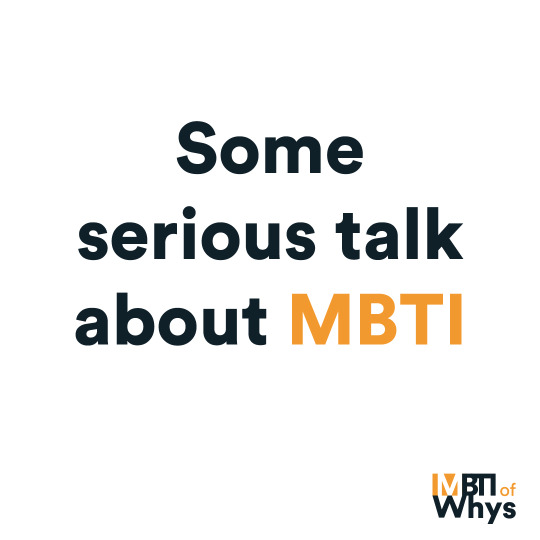
Disclaimer
Our vision regarding the use of MBTI, and typology in general, is profoundly different from what the Foundation promotes and advertises;
Our knowledge comes either from directly studying Jung’s works or from browsing more grassroots sources, such as blogs here on Tumblr or discussions on Reddit;
We opened this blog for fun because we’re passionate about typology and its application to both introspection and fictional works analysis;
We don’t intend to turn down every form of criticism, but without the pretense to be 100% correct, we rather wish to see what are real weak points and what may be legit observations if not born from a misunderstanding of the system;
This is our personal view and opinion on MBTI, feel free to join the debate!
Main concerns
Not scientifically sound
Not supported by the psychology academic field / It’s just pseudo-science It’s true that typology can’t be proven by the current scientific method - it’s too much of a subjective topic. There’s a reason why both Freud’s and Jung’s works are studied as the beginning of psychoanalysis but their practice isn’t used by modern psychology anymore. But admitting that MBTI isn’t scientifically sound doesn’t mean it’s entirely unreliable. The E/I dichotomy is, for example, something based on our chemicals and neurotransmitters in the brain, so it has a solid basis and it may be helpful outside the MBTI context. (source: 1, 2) The key point, we believe, is shifting the view: we prefer not to consider the Indicator as a pure psychological tool, rather a more philosophical one. MBTI is, at least for us mods, a method: we always try to improve our understanding of the subject, but it isn’t restricted to the theoretical field, since we also apply it in typing fictional characters. So, there’s a theoretical basis to know and personal study is encouraged, but it’s definitely nothing scientific as we intend it nowadays.
Tests aren’t accurate
We know - we talked about it here. Approaching MBTI solely by tests generates huge misunderstandings about what typology is really about. More specifically:
You can get different results by retaking the test It’s due to the flawed essence of a test assessing personality traits, and it’s exacerbated by tests having a general focus more on behavior than cognition. This is usually about generic questions that may be too vague since online tests try to be relatable to a large set of people from different countries and cultures.
Forer effect/ vague descriptions We know about the Forer effect and we’ve read the profiles used in his experiments: they’re nothing like detailed, in-depth profile and analysis of each type, or even basic ones, if done properly. Take a look at mbtinotes for an example of how different (if not opposite) descriptions are for different (or opposite) types. Even in a basic form, they’re not vague enough for a person to relate to more than three or four of them at most. So, it’s true that MBTI has, in some cases, a ‘pop’ approach aimed to be understandable and clear for everyone, and this is counterproductive in the end. But the flaw lays in how it is conveyed: inaccurate tests don’t invalidate the method as a whole.
It’s just a quiz/ it’s just like horoscopes The tests that bloom through the internet sadly validate the first point, as the majority of people answer the questions, read the type description, and then forget about it. But we firmly believe it’s nothing like the horoscopes. MBTI, if approached seriously, doesn’t have the pretense of predicting the future or explaining a person’s whole life, since it isn’t even an excuse for someone’s behaviors. It is true that many topics can be found about relationship pairs and career advice, but we tend to be skeptical towards those, and it’s not an approach we believe fit our vision of MBTI as a tool for self reflection. Type theory can give some insights on relationship dynamics in general (not only romantic ones) but this doesn’t mean it can predict the future or something along those lines.
Types are just stereotypes
They could be, depending on the interpretation. People are complex, they’re made of experiences, upbringing, hobbies, and so much more - personality is nothing more than a trait of someone’s individuality. One could say that people are not their type, rather they are somehow represented by it.
Putting something complex like personality into boxes People don’t know about cognitive functions based on Jung’s studies. Typology isn’t concerned about such things as hobbies or upbringing because - following Jung’s approach, at least - cognitive functions are innate and universal and determine one’s cognition. Meaning they can explain what information we prefer to look at, how we gather data, what we weight in making decisions. It’s all about the process - but the outcome and the individuality of a person, that’s on each one of us. This is also why tests are often inaccurate: they make examples based on careers, hobbies, and behaviors, leading MBTI enthusiasts to approach the subject as something more superficial than it actually is. However, the theory has its valid points, even if not always approved by academics, but it’s usually studied by a minority of people since (and it’s understandable, we aren’t judging) it requires time and effort to go deeper into the subject.
16 types are too few The four letters have meaning. Dichotomies exist, but they only work on a superficial level. In reality, the four functions are rather a continuum: they develop throughout a person’s entire life and work in pairs, three at a time, or even all fours together. The whole system is much more complex than people give it credit for by merely taking a test. And anyway, a person is much more than just their four letters. As we stated above it’s ok to stop on a more superficial level, but this mustn’t be used as an excuse to forget about cognitive functions and how they describe in a more detailed way how people gather and use information through cognitive patterns.
Personality changes over time It does because we change. But this doesn’t affect functions. What people call ‘change’ is tied to growing into a (hopefully) better person as life goes on, learning from one’s own mistakes, and thus becoming a more aware and balanced individual. However, the way in which a person gathers data and uses them doesn’t change, it’s more a process about enhancing our strengths and polishing our weaknesses. This, either, doesn’t mean a person’s fate is dictated by which functions they possess: this is a rather unhealthy approach to typology. Excluding circumstantial factors that sadly play a role in the real world (wealth, gender, geographic origin, and so on), idealistically a person could do everything in his life, despite type and whatnot. Maybe some things will be more difficult, or easier, but since we are more than our type, other factors come into play: how we’ve been raised, what we like, what ideals we have, who we are, globally, as a person. The list goes on.
MBTI is a form of discrimination
This can be true - but not for us. MBTI is a tool: what you do with it, it’s on your own. Stating that sadly, there are people who use MBTI as a form of discrimination doesn’t invalidate the subject.
Used in corporate settings, but not by psychologists We personally disapprove and discourage the use of MBTI to dictate people’s work and life. We don’t like how the Foundation promotes it for commercial purposes exactly because it is not a scientific nor a statistical tool. A person is more than four letters. Choosing a career based on an (often) inaccurate test is not advised, but understanding how our own cognition works may be useful to become a better person. Again, behaviors aren’t cognition.
Our personal dos and don’ts with MBTI
Do
Take it as a tool to promote introspection and self-reflection, but only after a proper study of the subject. We don’t recommend to use MBTI as a theory to dictate one’s career, but it’s still an interesting way to better understand oneself. Without falling into confirmation biases, MBTI may be a great way to become more aware of one’s own qualities and flaws, learning how to live in a more healthy and functional way.
Use it as a framework to dissect fictional works (very satisfying!)
Use it for meme material. Yes, memes have great potential and may light up your day!
Think of it as a pair of lenses: you can see reality through it and gain some nice insights but in the end, reality will always be so much more than what you can experience by only using a single pair of lenses.
Don’t
Use it as a replacement for professional help - both physically and mentally. Mental illnesses are unrelated to MBTI, so using the subject to validate them or deal with them may be harmful. MBTI is a great tool to better understand one’s strengths and weaknesses, not a replacement for proper treatment. There is no shame in being in need of help and we encourage you to seek it if necessary.
Use it to discriminate against other individuals - cognition doesn’t know gender, wealth, ethnicity, or education. There isn’t a better type, even if the community sometimes romanticizes certain ones. You are valid, no matter what a test says about you or what the community thinks.
Try to gain profit from it.
Use it to justify whatever behavior or decision you make in your life. Cognitive functions may help you to discover your patterns and how you act, but they can’t dictate what you can or can’t do.
Thank you for reading this article until the end. All of this is our personal view on the subject, so further discussion and contributions are encouraged and appreciated! If you are a beginner and wish to delve deeper into the subject, we’re not an educational blog, perperly, but here you can find a quick beginner’s guide.
Sources: Addressing typology and criticism; On the book ‘Personality Brokers’; The test is meaningless; How accurate is the test?; The test is unscentific; A popular but flawed understanding of personality.
#mbti#myers briggs#PersonalityTypes#Psychological Types#typology#criticism#stereotypes#articles#personality test#personality type#Personality Theory#mbti personality#debunking#introspection
2 notes
·
View notes
Text
𝕬𝖚𝖙𝖔𝖒𝖆𝖙𝖎𝖈 𝖊𝖓𝖈𝖔𝖚𝖓𝖙𝖊𝖗𝖘 | 30/03/20
For this week, we have a new workshop to do, tying into the first brief (Pick & Mix), focusing on surrealism and the theories linked with this by psychologist Sigmund Freud.
vimeo
Attached was the following text written by our teacher to introduce this workshop and the tasks that come with it;
“After a successful week with the post it note comic, and some excellent write ups that are really well documented, this week's task revisits some of the work from Term 1 (as we started in our drawing sessions) with some of the ideas stemming from Surrealism, dada and the psychoanalytical theories of Sigmund Freud.
This task is presented by Bristol based artist & animator Will Barras who will be offering commentary on your work at the end of the week. Follow the PDF attached and work through the tasks at your own pace. You have all week so take your time and experiment as much as possible.
We have more challenges to come, so try to put time into these as they will form the main body of your experimental work.
Upload your results and be as creative and imaginative as possible, but most importantly let go and embrace the ride.
Good luck peoples!”
Consider the primary objectives of a Final Project:
Collect information (Research)
Recall knowledge (Use learning)
Apply understanding through application and review (Propose & make exciting work and evaluate it)
I find that the above points refer to a simplified process of working through meet the final goal that is set by the FMP, althought this also applies to workshops and side projects that gets documented on this blog, as well as the productionfile.
Question: Are you doing these things and how can we improve and develop this?
I feel that I already do these, althought I yet have to further improve on evaluating the things I do, asking “Why” more often.
Answer: Experimentation - (The action or process of trying out new or revisiting ideas, method and activities)
≡≡≡≡≡ ≡≡≡≡≡ ≡≡≡≡≡ ≡≡≡≡≡ ≡≡≡≡≡ ≡≡≡≡≡ ≡≡≡≡≡ ≡≡≡≡≡ ≡≡≡≡≡
This weeks aims & objectives:
To review basic principles of automatic practice in relation to a specific artist
To experiment with working from abstract starting points
Be generate experimental work that shows progression of learning
To compare your work to the work of others

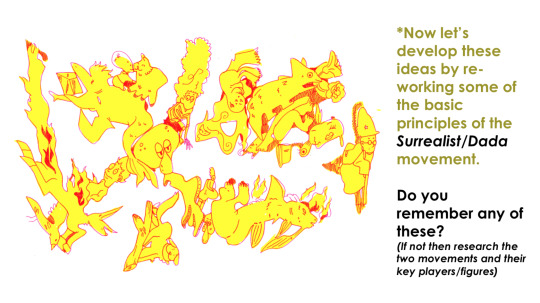
The surrealist/dada movement was an art movement, as well as a literary movement, that began around 1915 - 1917. Some of the key artists leading this movement was Hannah Höch, André Breton & Max Ernst. The movement aimed to break free from the chains that weighed down everyone during the great depression- The artistic field had now begun to evolve into a playground for ones’ imagination, challenging what used to not be acceptable in common culture.
Accident & chance
Embracing Improvisation (What does improvisation mean to you?)
BEING AUTOMATIC!
Surrealist automatism is a method of art-making in which the artist suppresses conscious control over the making process, allowing the unconscious mind to have great sway
Unlocking the unconscious mind.
In Sigmund Freud's psychoanalytic theory of personality, theunconscious mind is a reservoir of feelings, thoughts, urges, and memories that are outside of our conscious awareness.
≡≡≡≡≡ ≡≡≡≡≡ ≡≡≡≡≡ ≡≡≡≡≡ ≡≡≡≡≡ ≡≡≡≡≡ ≡≡≡≡≡ ≡≡≡≡≡ ≡≡≡≡≡
𝕽𝖊𝖘𝖊𝖆𝖗𝖈𝖍:
This weeks challenge for experimentation is bought to you by Bristol based urban artist and animator Will Barras. Your task is to analyse his work, considering the effect of the visual language (how he uses line and tone for example). Find out about him and considering the aforementioned surrealist principles write a short statement to suggest how he uses those principles in his own work.
Will Barras
vimeo

Illustrator, artist and animation director, Will Barras, currently lives and works in London, althought he grew up in Birmingham and later moved to Bristol to study graphic design. He quickly became known for being part of a group of young artists, working within Bristol’s street art scene. This then led to him appearing in a book titled “Scrawl”, alongside the artists Steff Plaetx and Duncan Jago, becoming a core and founding member of the Scrawl collective. “Scrawl”, originally published in 1999, was an influencial book made to document a new movement in street art, graphics and illustration.
Barras was selected to be one of the original artists for this collective. He was selected due to being renouned for his methods of portraying fluidity in movement. He also worked closely with creating pieces that were more narrativly driven compositions, incorperating such narratives into his line work. Barras’s unique composition of these three key elements, made his mark as an artist all the more inspiring, pushing new ideas against the grain of classic art. All of this has led his work to become staple pieces in many galleries across the globe. This includes Asia, Europe and the U.S.
He has painted a variety of different murals around the world, within this mix is one that he did with the members of his Bristol group at Tate Modern’s tubine hall, as well as one that he did for Pow!Wow! Festival in Taipei. In the studio Th1ng, located in central London, he worked as the head of animation.
Visual analysis and study:
His artwork has a very recongnizable style and feel to it. It has an urban flare to it, making it feel very fitting within the scene of street art.

“A big barn I painted in Dumfries with Amy Winstanley for the Spring Fling festival and Recoat gallery based in Glasgow.
http://www.amywinstanley.com
http://www.spring-fling.co.uk
http://www.recoatdesign.com”
The painting below has little information about it, as for what I can find, but somehow the piece almost speaks for itself. The play on perspective, composition and values is very eyecathing. It impresses me how he is able to convey motion to such an extend that you can almost just imagine it moving before your eyes, but perhaps that’s just me.

“#divinestyler #defmask #gammaproforma #kallenbachgallery”
I attemped to do some simple continuous warping animation to convey what I mean a little better:
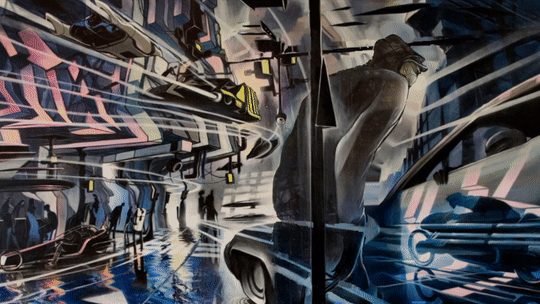
≡≡≡≡≡ ≡≡≡≡≡ ≡≡≡≡≡ ≡≡≡≡≡ ≡≡≡≡≡ ≡≡≡≡≡ ≡≡≡≡≡ ≡≡≡≡≡ ≡≡≡≡≡
𝖁𝖎𝖘𝖚𝖆𝖑 𝖆𝖈𝖙𝖎𝖛𝖎𝖙𝖞:
01: Using a wide brush create a large sheet of accidental/automatic/ unconscious blots & splatters, organics shapes and curvaceous marks using a range of coloured ink/paint. The brighter and more acidic the better!
Because of the fact that I don’t have paper made for paints/ink, I decided to try doing this task digitally- simulating the analogue look of watercolour or watered down ink, or even arcrylics.
I did this by using a variety of different watercolour brushes, made to emulate the look of the analogue mediums. I used them as randomly as I possibly could, trying not to plan where I would put the next brush stroke.
Once I had put down all the paint stokes, I then went over it while the layer was locked with a big soft edged brush, layering up different colours until I was happy with how it looked.
02: Make 3-4 sheets of these and then let them dry.
Digital 01:
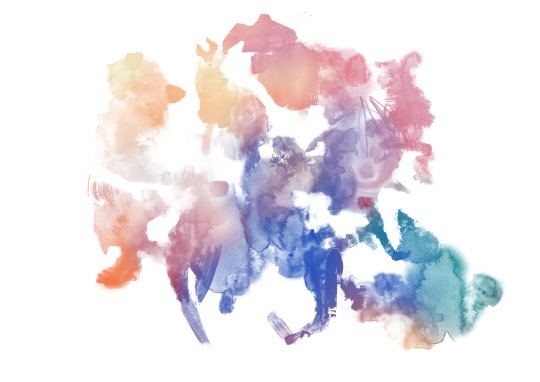
Digital 02:
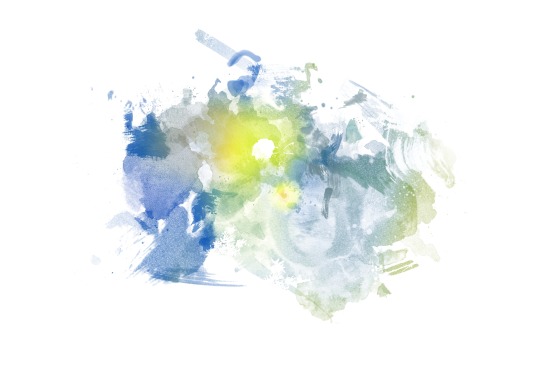
03: Then using fineliner develop these marks into faces/characters/scenes by adding details/features and developing these into detail illustrations that are spontaneous and free flowing.
For the linework, I primarily used one single brush; hard edged and circular. (The one selected in the picture below)

I chose this for the reason being that I have found it to be very responsive to the use of a drawing tablet & pen. It does a good job at making expressive lines with its tilt sensitivity, making it a pleasure to use; It reminds me of how brush pens work and feel.
Here are a few tests on some of the lines I can create with it;
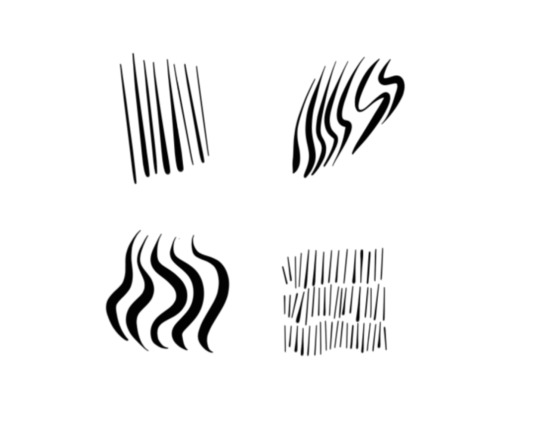
≡≡≡≡≡ ≡≡≡≡≡ ≡≡≡≡≡ ≡≡≡≡≡ ≡≡≡≡≡ ≡≡≡≡≡ ≡≡≡≡≡ ≡≡≡≡≡ ≡≡≡≡≡
Digital 01:
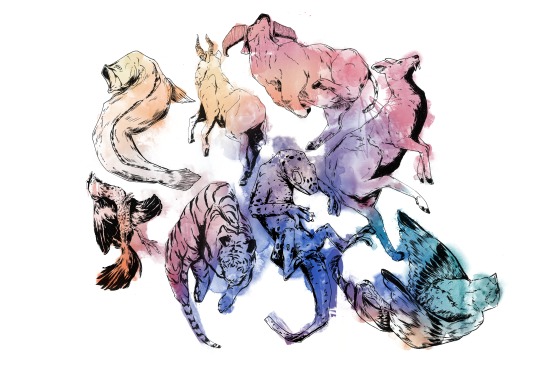
Digital 02:
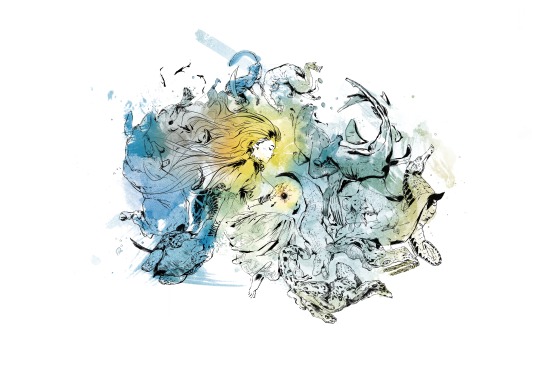
≡≡≡≡≡ ≡≡≡≡≡ ≡≡≡≡≡ ≡≡≡≡≡ ≡≡≡≡≡ ≡≡≡≡≡ ≡≡≡≡≡ ≡≡≡≡≡ ≡≡≡≡≡
Digital 02: Process
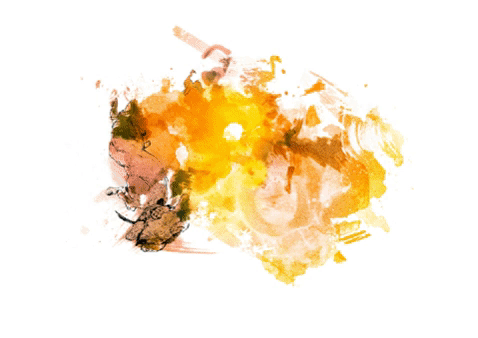
1. I have always found that beginning these blob doodles are the most diffucult for me. Perhaps because it takes me a little while to really get into the flow of continously seeing images in the randomness.
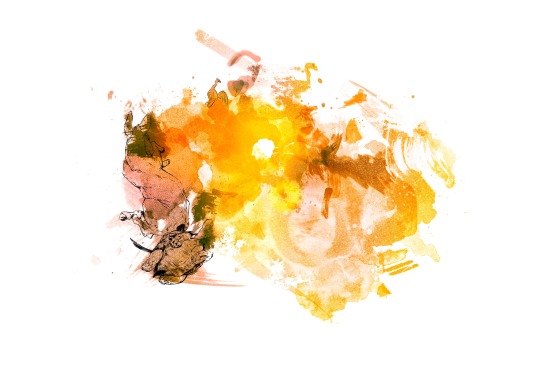
2. I began from the left, slowly working my way to the right and the top, since I felt that I had more clear lines to go from being around the edge of the paint.
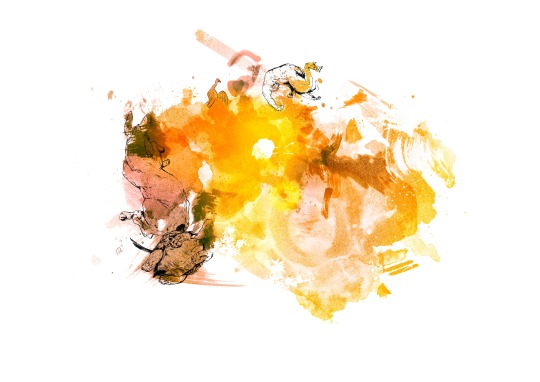
3. Eventually I braved it and went right for the middle of the piece. This was the turning point for me in the process of doing this. It enabled me to truly let get, have fun, and not feel intimidated and nervous to do the next doodle.
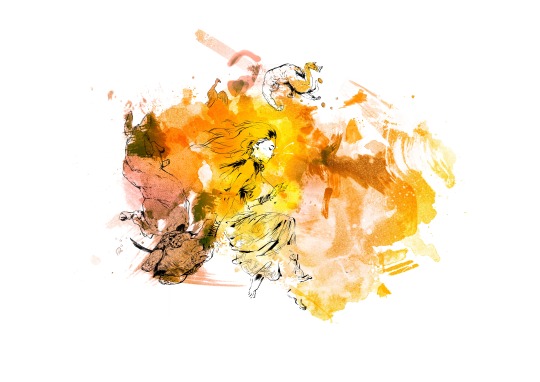
4. This is when I began drawing creatures of the sea, slowly building up a story/narrative.
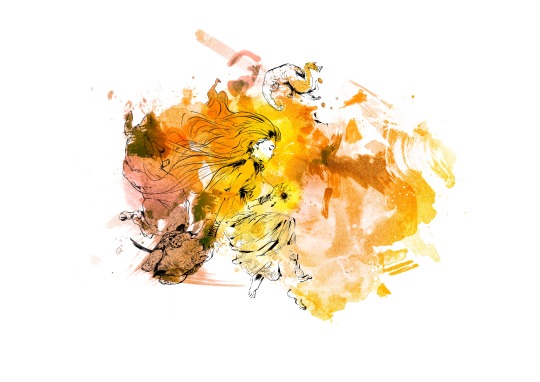
5. I don’t actually remember what I was even thinking at this point anylonger- I was simply just letting the pen guide me around the canvas; letting it all flow together however it felt as to do so.
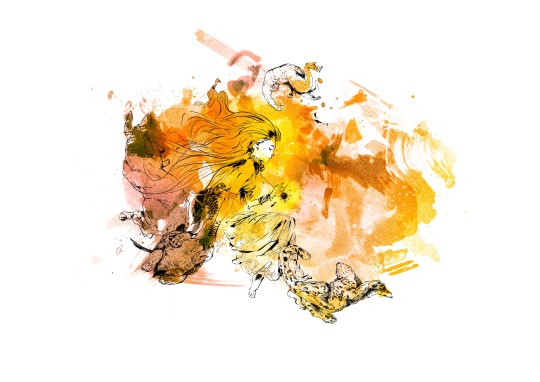
6. I began to delve into the little details. I felt as if they would add to the general flow of the piece; being busy, yet in a manner that lets your eyes wander with curiosity.
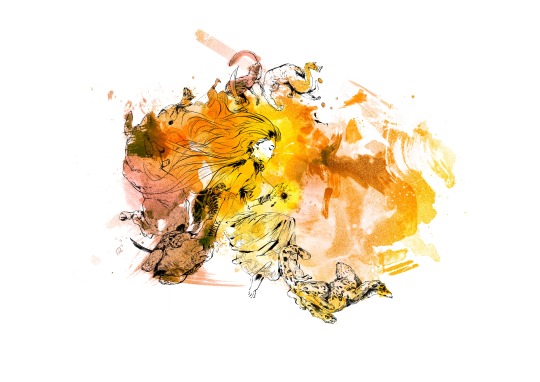
7. I was now moving on to doing the right side of the piece. I had a little more trouble visualising the top right corner, so I did that last.
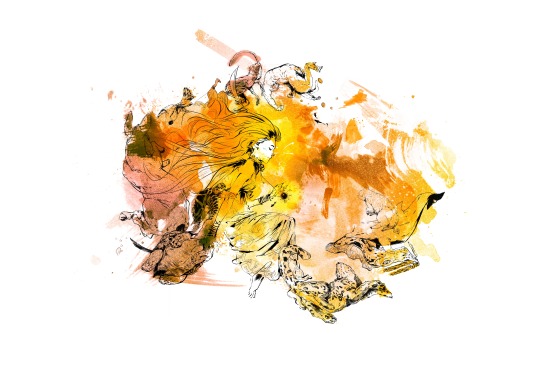
8. At this point I felt a little stuck as to what to do, hence it being, yet again, dedicated for adding some more little details here and there.
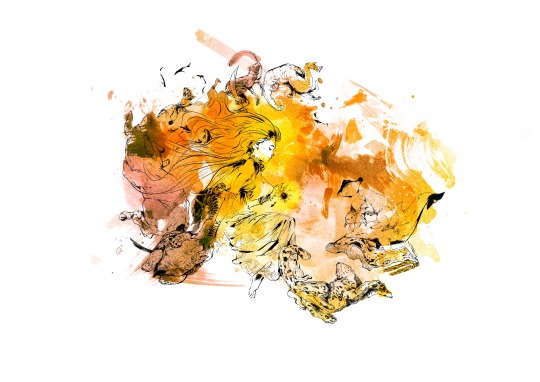
9. Eventually I overcame the frustration I had built up and took to do the right side of the artwork.
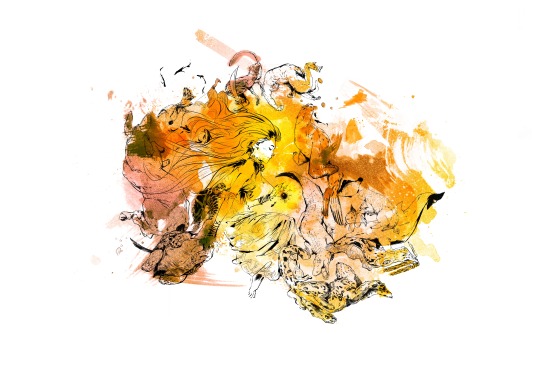
10. I tried to convey motion and flow by the way the animals are positioned and posed, trying to make it calm in the middle where the girl is, and then busy/chaotic the further away you get from her.
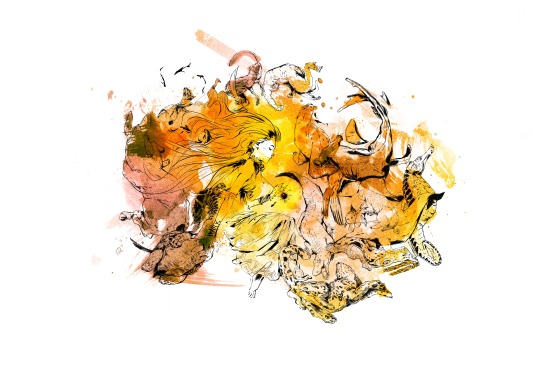
11. This second to last step was, again, for adding detail. I wanted to fill up any bits that I felt appeared too empty and spaced out, so to no disrupt the feeling of flow in the painting.
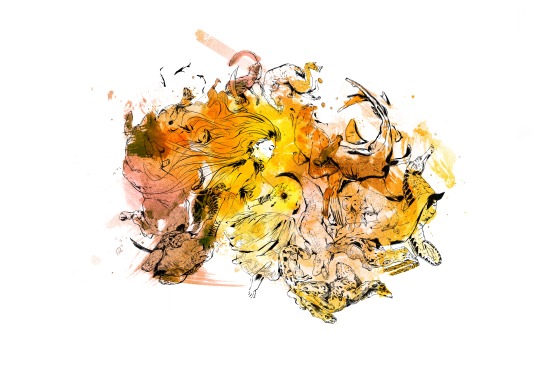
12. With the inking done and rendered to my satisfaction, the last step was to play around with colours.

≡≡≡≡≡ ≡≡≡≡≡ ≡≡≡≡≡ ≡≡≡≡≡ ≡≡≡≡≡ ≡≡≡≡≡ ≡≡≡≡≡ ≡≡≡≡≡ ≡≡≡≡≡
Digital 01: Colour variations
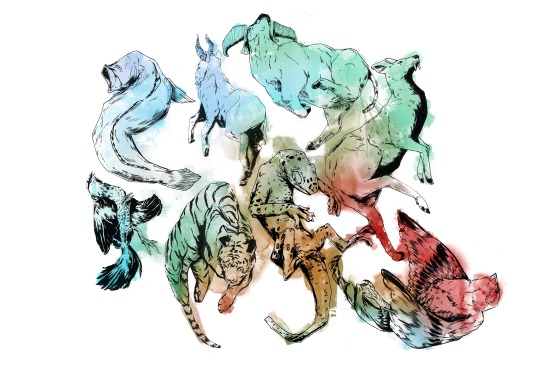
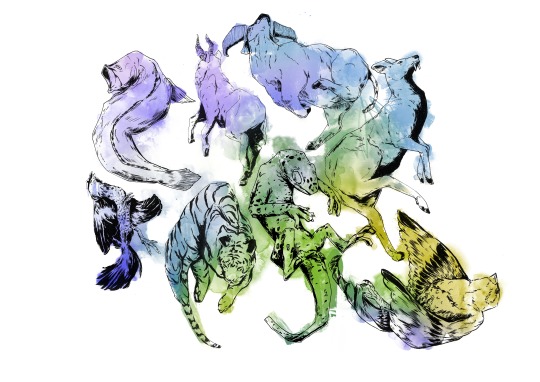
Digital 02: Colour variations
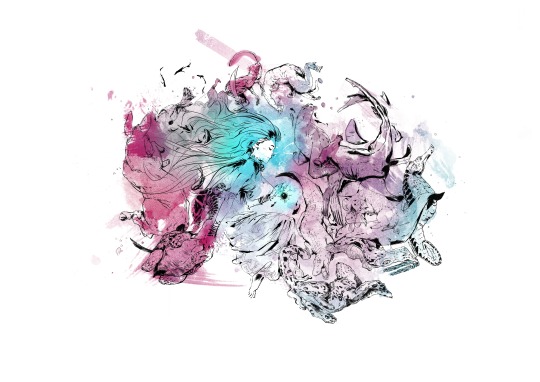
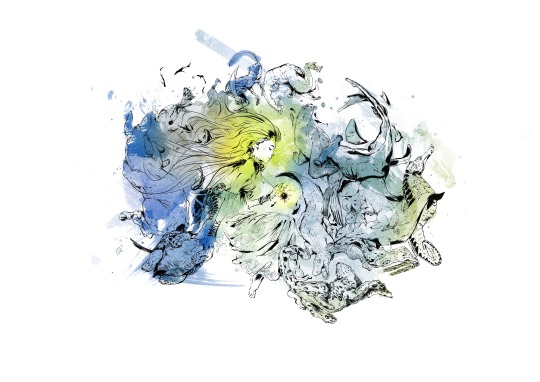
04: Scan/photograph and upload to Moodle.
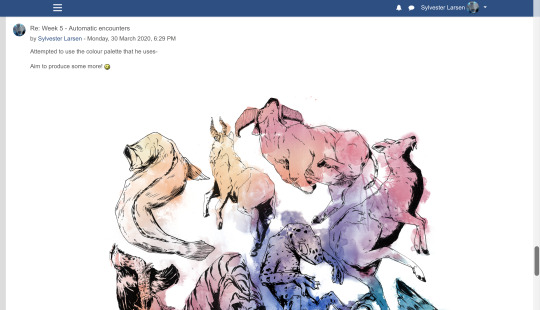

≡≡≡≡≡ ≡≡≡≡≡ ≡≡≡≡≡ ≡≡≡≡≡ ≡≡≡≡≡ ≡≡≡≡≡ ≡≡≡≡≡ ≡≡≡≡≡ ≡≡≡≡≡
𝕱𝖎𝖓𝖆𝖑 𝖗𝖊𝖛𝖎𝖊𝖜 𝖆𝖓𝖉 𝖗𝖊𝖋𝖑𝖊𝖈𝖙𝖎𝖔𝖓:
Which of these words would you use when discussing the work of Will Barras and your own art pieces:

I would most definitly use;
Organic/Fluid
Figurative
Automatic
On top of these I would probably add;
Harmonic
Dynamic
Epochal
Visionary
Can you construct a comparative sentence/paragraph using at least 5 of these words. What are the differences and similarities between the works you have created. What conclusions did you make about this experimentation?
2 notes
·
View notes
Text
**Social media- **what is and what it does
I have since a very long time been monitoring the use of social media.
To be honest growing up i was quite hesitant to be on social media as i thought it would drown my brain.
But today we're here with you to discuss the good and the bad of social media that are used in todays adolescents.
First of we need to know what social media is:
Social media refers to websites and applications that are designed to allow people to share content quickly, efficiently, and in real-time.
Social media is also seen as a platform for many groups and ethnicities.
For many it is seen as as a show case of talents, entertainment,personalities, characteristics, and especially their voices.
Next we need to know the platforms they used:
the youths that we've primarily come across upon use the social media outlets:
Instagram
Snapchat
Twitter
Facebook
Whatsapp
Tik Tok
Youtube
Tumblr
To begin with comprehending our youth we need to understand what they use their outlets for.
You can see many of todays youths on social media. Some using it as their personal platform others using it to conceive trends, observing nearly worshipping their idols, forms of communication, its also a look into the daily lives of each other.
For instance: celebrity crush and idols
they are the people kids look up to and use as their role models or envision themselves in that role one day whether be reality or a dream.
It gives them something to reach out to, sort of like a goal
As for media entertainment
we all know the use of memes and the use of it for our personal comic relief.
We all spend countless hours looking at memes and youtube videos but what if we could use this entertainment to stimulate and help evolve the adolescent brain development.
In the form of generating their own memes or social vids that are informative.
Gaming and YouTube has vastly taken over the social platform stage.
They are also some of the more novice lucrative ways of making money on a social platform.
Take for instance that recently there was a video game tournament for fortnite where a young teen won over a million dollars by becoming its first tournament winner.
And what better way to broadcast that same tournament but on YouTube.
Where millions of viewers logged in and the broadcaster got paid by the sum of viewers he/ she had.
Psychoanalysis was founded by Sigmund Freud (1856-1939). Freud believed that people could be cured by making conscious their unconscious thoughts and motivations, thus gaining insight.
The aim of psychoanalysis therapy is to release repressed emotions and experiences, i.e., make the unconscious conscious. It is only having a cathartic (i.e., healing) experience can the person be helped and "cured."
Click here for a video on the theory of psycho analysis
psycho analysis is crucial to understand because if we do then we know our brain develops even in our sleep. And if teens constantly are on social media or social networks and video games it can affect their sleep and the wake up restless, or even worse more dedicated to the social outlets as not to feel left out.
One way we can help beat this is 3 hours before bed time all phones away and give the brain a stimulating activity so that it can function up to speed and breathe and eat knowledge as it is meant to .
Implement family night with boardgames or trivia or a fun activity outsides that can help build your social recognizance.
Giving your body and brain diversity keeps it sharp and uplifting and gives you those extra tools for life.
For instance some of the social idols for todays teens can be what we call social influencers.
A social influencer is someone who uses their social media status to push products on their young audience to buy said product on their social media page for what said influencer is paid for by the brand.
See video: https://www.youtube.com/watch?v=5SOFSjlU0fM
on a site called mom junction I found 11 positive and negative influences of teen on social media
https://www.momjunction.com/articles/positive-and-negative-influences-of-media-on-teenagers_00107975/
I will just use 2 of each:
Help Develop Social Skills:
Many teens are socially awkward. Media gives them the chance to groom their social skills. It also gives them the chance to expand their social circle and develop new friendships. Other benefits include social confidence, heightened literacy in the media, and more social support. Social media diversifies your teen’s social skills, which in turn helps him navigate successfully through modern society
Inspire Them:
When your teen watches an action flick, don’t just despair about the violence. With a little guidance, they can use the movie as inspiration! Maybe your teen will decide to take up martial arts training, all thanks to a Bruce Lee movie! Teenagers look up to celebrities, and when a celebrity tells them to stay off drugs, they just might listen.
Negative theories
Risky Sexual Behavior:
Teenagers are just discovering their sexuality. It is very normal for them to be interested in everything sexual. But the amount of sex in media today can make a teenager confused. Sex without responsibility – that seems to be the message being beamed at teenagers. This can lead to irresponsible sexual behavior and unwanted pregnancies.
[ Read:Teenage Social Media Addiction]
Making Everything Commercial:
Happiness comes at a price. At least that’s the message teenagers get through media. Their life would be perfect if only you’d buy them that hot new game, that happening dress. Advertisers target teenagers to ramp up their revenues. But teenagers fall prey to the idea of commercialization of happiness.
According to Erickson’s Developmental theory, an individual faces a developmental crisis at each stage ( a conflict between a positive alternative and a potentially unhealthy alternative). “…The emphasis on ones own identity at a point in time when the way forward was no longer determined by ones parents or by society…resulting in a crisis of identity”. (westenberg 2008:2)
Now that we have that tackled, let us discuss some of the good of social media:
Ive mentioned previously above that social media is a platform:
for instance the parkland shooting in the united states where a group of students took to social media to voice their opinions after surviving yet another tragic massacre and became activist in their own rights to fight against NRA and force a national debate.
https://www.vox.com/2018/2/26/17054408/parkland-shooting-activist-teens-gun-control
if we were to apply Urie Bronfebenner's theory of Ecological Theory of Human Development.
Urie Bronfenbrenner (April 29, 1917 – September 25, 2005) was a Russian-born American psychologist who is most known for his ecological systems theory.[1] His work with the United States government helped in the formation of the Head start program in 1965.[2] Bronfenbrenner's ability research was key in changing the perspective of developmental psychology by calling attention to the large number of environmental and societal influences on child development.
Or young high school or college students or athletes using their popularity on social media to spread the knowledge of social injustice
As you can see young adults have used social media to help lead them along the way to do great things these are the most beautiful forms of social media.
Then of course there is the ugly.
Social media is also an open platform, for some it can allow you to be subsequent to
for instance research has shown that spending to much time on social media can lead lead to depression .
As noted by such research sites such as ivesciences
https://www.livescience.com/51294-cyberbullying-social-media-teen-depression.html
Don't get me with twisted everything in this life there are the good and the bad.
Take for instance social media have given us the means to reach millions if not billions of people across the globe to relay our message but it can also allow you to portray just a an image of yourself but factual and superficial.
CYBERBULLYING
Do you know the dangers of cyber bullying?
Cyber bullying has taken on one of the worst form of emotional en mental damage to it's victims.
There have been an extreme amount of cyber bullying that has led to the victims committing suicide.
I don't know about you but no child should have o go through so much that they rather take their own lives because of such cowardly behavior from another that hides behind a sometimes fake profile.
Here is an article from lie science backing thees findings:
https://www.livescience.com/51294-cyberbullying-social-media-teen-depression.html
For instance in adolescents cat fishing has been major issue.
For those who don't know catfish(ing ) is pretending to be someone your not on he internet/ social media .
The most cat-fishers claim to show interest in you and try to either make you fall in love with them or to manipulate you for their own personal cause.
https://socialnewsdaily.com/11296/catfishing-infographic/
Cat-fishing is often employed for romance scams,on dating websites. Cat-fishing may be used for financial gain, to compromise a victim in some way, or simply as a form of trolling or wish fulfillment.Sadly the study found that cat-fishers will use traumatic experiences such as cancer, accidents and death to avoid meeting their victims in real life.
As we look into the psychological make up of cat-fishing its almost always done by one person making of a fake social media platform. It is because it is so easy to mask our through selves behind the windows of social media. Another bad reference is that it is now easier for bullies and psychopaths to reach our youth online through social media.
Other platforms with social media use
Lets take a look into the platform that our adolescents role into.
For instance youtube, youtube was seen for many years as just a media outlet where we could watch short documentaries and comedy stints and especially watch music videos.
Nowadays youtube has a huge role into social media and social development of todays youth.
Yes i know the argument would come as wow really (sarcastically) and others would say thats always been the way it has been ( true) but never like before.
Just a few insight as to what goes on you tube you can see stuff like live video gaming where you can talk to and relate your skills.
https://www.youtube.com/watch?v=ft54bgeMBlg
https://www.youtube.com/watch?v=Qc-vvpFft2c
https://video.fosterwebmarketing.com/fosterwebmarketing.com/httpdocs/evm/1080_fosterwebmarketing_017_gina_youtube_h264_640x360.mp4
Also where the can communicate with anime pages, show their life with life vlogs and star in their own reality clips, put on their own personal showcases with live interaction.
The've built up a platform where they can showcase their many talents.
For instance Justin Bieber himself was discovered on youtube and signed a record deal as a teenager.
But social media can also lead to the a substantial difference to the development of the adolescent brain, if you click on the lick here under you can see a couple of test run on teenagers who are on social media and how their brains develop.
https://www.youtube.com/watch?v=7QWoP6jJG3k
**Where do i belong **
We have seen an outstanding amount of young people all searching to find their peers and to adhere to whatever social group.
Take for instance such support groups that help them deal with their sexuality, ideology and identity
LBGTQ
Feminism
race
beliefs & religion
sex & sexual experimenting
social experimenting
every teen wants to find his or her social group or spot in society; and social media in its various forms helps to steer them to that source.
We should always pay attention to our students and kids for they are discovering their paths be it good or bad they will find person or social peers who share their interest.
Piaget (1936) was the first psychologist to make a systematic study of cognitive development.
Sensorimotor stage: birth to 2 years
Preoperational stage: ages 2 to 7
Concrete operational stage: ages 7 to 11
Formal operational stage: ages 12 and up
The Sensorimotor Stage
Major Characteristics and Developmental Changes:
The infant knows the world through their movements and sensations
Children learn about the world through basic actions such as sucking, grasping, looking, and listening
Infants learn that things continue to exist even though they cannot be seen (object permanence)
They are separate beings from the people and objects around them
They realize that their actions can cause things to happen in the world around them
During this earliest stage of cognitive development, infants and toddlers acquire knowledge through sensory experiences and manipulating objects. A child's entire experience at the earliest period of this stage occurs through basic reflexes, senses, and motor responses.T
The Preoperational Stage
Major Characteristics and Developmental Changes:
Children begin to think symbolically and learn to use words and pictures to represent objects.
Children at this stage tend to be egocentric and struggle to see things from the perspective of others.
While they are getting better with language and thinking, they still tend to think about things in very concrete terms.
The foundations of language development may have been laid during the previous stage, but it is the emergence of language that is one of the major hallmarks of the preoperational stage of development
The Concrete Operational Stage
Major Characteristics and Developmental Changes
During this stage, children begin to thinking logically about concrete events
They begin to understand the concept of conservation; that the amount of liquid in a short, wide cup is equal to that in a tall, skinny glass, for example
Their thinking becomes more logical and organized, but still very concrete
Children begin using inductive logic, or reasoning from specific information to a general principle
While children are still very concrete and literal in their thinking at this point in development, they become much more adept at using logic.2 The egocentrism of the previous stage begins to disappear as kids become better at thinking about how other people might view a situation.
The Formal Operational Stage
Major Characteristics and Developmental Changes:
At this stage, the adolescent or young adult begins to think abstractly and reason about hypothetical problems
Abstract thought emerges
Teens begin to think more about moral, philosophical, ethical, social, and political issues that require theoretical and abstract reasoning
Begin to use deductive logic, or reasoning from a general principle to specific information
The final stage of Piaget's theory involves an increase in logic, the ability to use deductive reasoning, and an understanding of abstract ideas.3 At this point, people become capable of seeing multiple potential solutions to problems and think more scientifically about the world around them.
In theory we as teachers should not fear the use of social media but instead learn to harness its powers.
To use it as our umbrella to educate by implementing it into our lessons we can control it for the mos.
For instance the making of a social media portfolio where they can use social media better in there english class and basically amy skill set you want to embody on todays adolescents.
For some of us with teenage students we can find it off putting but by my observations there are some differential factors in the use of social media and their personal development from said social society.
Some of the factors are :
Culture/ region of upbringing
Race
Morals and values
Religion
and of course age
With all of these factors we should always monitor our children/ students and have them take time for a detox.
We should also try not to hover over them but enlighten them and instead of nag give them a sense of responsibility where then their brain can develop in multiple ways. Think of it as exercise for the brain.
**Live Long and Prosper & Remember to Elevate and Educate **
1 note
·
View note
Text
The Health unto Death – If such a thing as a psycho-analysis of today’s prototypical culture were possible; if the absolute predominance of the economy did not beggar all attempts at explaining conditions by the psychic life of their victims; and if the psychoanalysts had not long since sworn allegiance to those conditions – such an investigation would needs show the sickness proper to the time to consist precisely in normality. The libidinal achievements demanded of an individual behaving as healthy in body and mind, are such as can be performed only at the cost of the profoundest mutilation, of internalized castration in extroverts, beside which the old renunciation of identification with the father is the child’s play as which it was first rehearsed. The regular guy, the popular girl, have to repress not only their desires and insights, but even the symptoms that in bourgeois times resulted from repression. Just as the old injustice is not changed by a lavish display of light, air and hygiene, but is in fact concealed by the gleaming transparency of rationalized big business, the inner health of our time has been secured by blocking flight into illness without in the slightest altering its aetiology. The dark closets have been abolished as a troublesome waste of space, and incorporated in the bathroom. What psycho-analysis suspected, before it became itself a part of hygiene, has been confirmed. The brightest rooms are the secret domain of faeces. The verses: ‘Wretchedness remains. When all is said, / It cannot be uprooted, live or dead. / So it is made invisible instead’, are still more true of the psychic economy than of the sphere where abundance of goods may temporarily obscure constantly increasing material inequalities. No science has yet explored the inferno in which were forged the deformations that later emerge to daylight as cheerfulness, openness, sociability, successful adaptation to the inevitable, an equable, practical frame of mind. There is reason to suppose that these characteristics are laid down at even earlier phases of childhood development than are neuroses: if the latter result from a conflict in which instinct is defeated, the former condition, as normal as the damaged society it resembles, stems from what might be called a prehistoric surgical intervention, which incapacitates the opposing forces before they have come to grips with each other, so that the subsequent absence of conflicts reflects a predetermined outcome, the a priori triumph of collective authority, not a cure effected by knowledge. Unruffled calm, already a prerequisite for applicants receiving highly-paid posts, is an image of the stifled silence that the employers of the personnel manager only later impose politically. The only objective way of diagnosing the sickness of the healthy is by the incongruity between their rational existence and the possible course their lives might be given by reason. All the same, the traces of illness give them away: their skin seems covered by a rash printed in regular patterns, like a camouflage of the inorganic. The very people who burst with proofs of exuberant vitality could easily be taken for prepared corpses, from whom the news of their not-quite-successful decease has been withheld for reasons of population policy. Underlying the prevalent health is death. All the movements of health resemble the reflex-movements of beings whose hearts have stopped beating. Scarcely ever does an unhappily furrowed brow, bearing witness to terrible and long-forgotten exertions, or a moment of pathic stupidity disrupting smooth logic, or an awkward gesture, embarrassingly preserve a trace of vanished life. For socially ordained sacrifice is indeed so universal as to be manifest only in society as a whole, and not in the individual. Society has, as it were, assumed the sickness of all individuals, and in it, in the pent-up lunacy of Fascist acts and all their innumerable precursors and mediators, the subjective fate buried deep in the individual is integrated with its visible objective counterpart. And how comfortless is the thought that the sickness of the normal does not necessarily imply as its opposite the health of the sick, but that the latter usually only present, in a different way, the same disastrous pattern.
This side of the pleasure principle . – The repressive traits in Freud have nothing to do with the want of human warmth that businesslike revisionists point to in the strict theory of sexuality. Professional warmth, for the sake of profit, fabricates closeness and immediacy where people are worlds apart. It deceives its victim by affirming in his weakness the way of the world which made him so, and it wrongs him in the degree that it deviates from truth. If Freud was deficient in such human sympathy, he would in this at least be in the company of the critics of political economy, which is better than that of Tagore or Werfel. 1 The fatality was rather that, in the teeth of bourgeois ideology, he tracked down conscious actions materialistically to their unconscious instinctual basis, but at the same time concurred with the bourgeois contempt of instinct which is itself a product of precisely the rationalizations that he dismantled. He explicitly aligns himself, in the words of the Introductory Lectures , with ‘the general evaluation … which places social goals higher than the fundamentally selfish sexual ones’. As a specialist in psychology, he takes over the antithesis of social and egoistic, statically, without testing it. He no more discerns in it the work of repressive society than the trace of the disastrous mechanisms that he has himself described. Or rather, he vacillates, devoid of theory and swaying with prejudice, between negating the renunciation of instinct as repression contrary to reality, and applauding it as sublimation beneficial to culture. In this contradiction something of the Janus-character of culture exists objectively, and no amount of praise for healthy sensuality can wish it away. In Freud, however, it leads to a devaluation of the critical standard that decides the goal of analysis. Freud’s unenlightened enlightenment plays into the hands of bourgeois disillusion. As a late opponent of hypocrisy, he stands ambivalently between desire for the open emancipation of the oppressed, and apology for open oppression. Reason is for him a mere superstructure, not – as official philosophy maintains – on account of his psychologism, which has penetrated deeply enough into the historical moment of truth, but rather because he rejects the end, remote to meaning, impervious to reason, which alone could prove the means, reason, to be reasonable: pleasure. Once this has been disparagingly consigned to the repertoire of tricks for preserving the species, and so itself exposed as a cunning form of reason, without consideration of that moment in pleasure which transcends subservience to nature, ratio is degraded to rationalization. Truth is abandoned to relativity and people to power. He alone who could situate utopia in blind somatic pleasure, which, satisfying the ultimate intention, is intentionless, has a stable and valid idea of truth. In Freud’s work, however, the dual hostility towards mind and pleasure, whose common root psycho-analysis has given us the means for discovering, is unintentionally reproduced. The place in the Future of an Illusion where, with the worthless wisdom of a hard-boiled old gentleman, he quotes the commercial-traveller’s dictum about leaving heaven to the angels and the sparrows, 1 should be set beside the passage in the Lectures where he damns in pious horror the perverse practices of pleasure-loving society. Those who feel equal revulsion for pleasure and paradise are indeed best suited to serve as objects: the empty, mechanized quality observable in so many who have undergone successful analysis is to be entered to the account not only of their illness but also of their cure, which dislocates what it liberates. The therapeutically much-lauded transference, the breaking of which is not for nothing the crux of analytic treatment, the artificially contrived situation where the subject performs, voluntarily and calamitously, the annulment of the self which was once brought about involuntarily and beneficially by erotic self-abandonment, is already the pattern of the reflex-dominated, follow-my-leader behaviour which liquidates, together with all intellect, the analysts who have betrayed it.
Invitation to the dance . – Psycho-analysis prides itself on restoring the capacity for pleasure, which is impaired by neurotic illness. As if the mere concept of a capacity for pleasure did not suffice gravely to devalue such a thing, if it exists. As if a happiness gained through speculation on happiness were not the opposite, a further enroachment of institutionally planned behaviour-patterns on the ever-diminishing sphere of experience. What a state the dominant consciousness must have reached, when the resolute proclamation of compulsive extravagance and champagne jollity, formerly reserved to attachés in Hungarian operettas, is elevated in deadly earnest to a maxim of right living. Prescribed happiness looks exactly what it is; to have a part in it, the neurotic thus made happy must forfeit the last vestige of reason left to him by repression and regression, and to oblige the analyst, display indiscriminate enthusiasm for the trashy film, the expensive but bad meal in the French restaurant, the serious drink and the love-making taken like medicine as ‘sex’. Schiller’s dictum that ‘Life’s good, in spite of all’, papier-mâché from the start, has become idiocy now that it is blown into the same trumpet as omnipresent advertising, with psychoanalysis, despite its better possibilities, adding its fuel to the flames. As people have altogether too few inhibitions and not too many, without being a whit the healthier for it, a cathartic method with a standard other than successful adaptation and economic success would have to aim at bringing people to a consciousness of unhappiness both general and – inseparable from it – personal, and at depriving them of the illusory gratifications by which the abominable order keeps a second hold on life inside them, as if it did not already have them firmly enough in its power from outside. Only when sated with false pleasure, disgusted with the goods offered, dimly aware of the inadequacy of happiness even when it is that – to say nothing of cases where it is bought by abandoning allegedly morbid resistance to its positive surrogate – can men gain an idea of what experience might be. The admonitions to be happy, voiced in concert by the scientifically epicurean sanatorium-director and the highly-strung propaganda chiefs of the entertainment- industry, have about them the fury of the father berating his children for not rushing joyously downstairs when he comes home irritable from his office. It is part of the mechanism of domination to forbid recognition of the suffering it produces, and there is a straight line of development between the gospel of happiness and the construction of camps of extermination so far off in Poland that each of our own countrymen can convince himself that he cannot hear the screams of pain. That is the model of an unhampered capacity for happiness. He who calls it by its name will be told gloatingly by psycho-analysis that it is just his Oedipus complex.
Ego is Id . – A connection is commonly drawn between the development of psychology and the rise of the bourgeois individual, both in Antiquity and since the Renaissance. This ought not to obscure the contrary tendency also common to psychology and the bourgeois class, and which today has developed to the point of excluding all others: the suppression and dissolution of the very individual in whose service knowledge was related back to its subject. If all psychology since that of Protagoras has elevated man by conceiving him as the measure of all things, it has thereby also treated him from the first as an object, as material for analysis, and transferred to him, once he was included among them, the nullity of things. The denial of objective truth by recourse to the subject implies the negation of the latter: no measure remains for the measure of all things; lapsing into contingency, he becomes untruth. But this points back to the real life-process of society. The principle of human domination, in becoming absolute, has turned its point against man as the absolute object, and psychology has collaborated in sharpening that point. The self, its guiding idea and its a priori object, has always, under its scrutiny, been rendered at the same time non-existent. In appealing to the fact that in an exchange society the subject was not one, but in fact a social object, psychology provided society with weapons for ensuring that this was and remained the case. The dissection of man into his faculties is a projection of the division of labour onto its pretended subjects, inseparable from the interest in deploying and manipulating them to greater advantage. Psycho-technics is not merely a form of psychology’s decay, but is inherent in its principle. Hume, whose work bears witness in every sentence to his real humanism, yet who dismisses the self as a prejudice, expresses in this contradiction the nature of psychology as such. In this he even has truth on his side, for that which posits itself as ‘I’ is indeed mere prejudice, an ideological hypostasization of the abstract centres of domination, criticism of which demands the removal of the ideology of ‘personality’. But its removal also makes the residue all the easier to dominate. This is flagrantly apparent in psycho-analysis. It incorporates personality as a lie needed for living, as the supreme rationalization holding together the innumerable rationalizations by which the individual achieves his instinctual renunciation, and accommodates himself to the reality principle. But precisely in demonstrating this, it confirms man’s non-being. Alienating him from himself, denouncing his autonomy with his unity, psycho-analysis subjugates him totally to the mechanism of rationalization, of adaptation. The ego’s unflinching self-criticism gives way to the demand that the ego of the other capitulate. The psycho-analyst’s wisdom finally becomes what the Fascist unconscious of the horror magazines takes it for: a technique by which one particular racket among others binds suffering and helpless people irrevocably to itself, in order to command and exploit them. Suggestion and hypnosis, rejected by psycho-analysis as apocryphal, the charlatan magician masquerading before a fairground booth, reappear within its grandiose system as the silent film does in the Hollywood epic. What was formerly help through greater knowledge has become the humiliation of others by dogmatic privilege. All that remains of the criticism of bourgeois consciousness is the shrug with which doctors have always signalled their secret complicity with death. – In psychology, in the bottomless fraud of mere inwardness, which is not by accident concerned with the ‘properties’ of men, is reflected what bourgeois society has practised for all time with outward property. The latter, as a result of social exchange, has been increased, but with a proviso dimly present to every bourgeois. The individual has been, as it were, merely invested with property by the class, and those in control are ready to take it back as soon as universalization of property seems likely to endanger its principle, which is precisely that of withholding. Psychology repeats in the case of properties what was done to property. It expropriates the individual by allocating him its happiness.
Always speak of it, never think of it . – Now that depth-psychology, with the help of films, soap operas and Horney, has delved into the deepest recesses, people’s last possibility of experiencing themselves has been cut off by organized culture. Ready-made enlightenment turns not only spontaneous reflection but also analytical insights – whose power equals the energy and suffering that it cost to gain them – into mass-produced articles, and the painful secrets of the individual history, which the orthodox method is already inclined to reduce to formulae, into commonplace conventions. Dispelling rationalizations becomes itself rationalization. Instead of working to gain self-awareness, the initiates become adept at subsuming all instinctual conflicts under such concepts as inferiority complex, mother-fixation, extroversion and introversion, to which they are in reality inaccessible. Terror before the abyss of the self is removed by the consciousness of being concerned with nothing so very different from arthritis or sinus trouble. Thus conflicts lose their menace. They are accepted, but by no means cured, being merely fitted as an unavoidable component into the surface of standardized life. At the same time they are absorbed, as a general evil, by the mechanism directly identifying the individual with social authority, which has long since encompassed all supposedly normal modes of behaviour. Catharsis, unsure of success in any case, is supplanted by pleasure at being, in one’s own weakness, a specimen of the majority; and rather than gaining, like inmates of a sanatorium in former days, the prestige of an interesting pathological case, one proves on the strength of one’s very defects that one belongs, thereby transferring to oneself the power and vastness of the collective. Narcissism, deprived of its libidinal object by the decay of the self, is replaced by the masochistic satisfaction of no longer being a self, and the rising generation guards few of its goods so jealously as its selflessness, its communal and lasting possession. The realm of reification and standardization is thus extended to include its ultimate contradiction, the ostensibly abnormal and chaotic. The incommensurable is. made, precisely as such, commensurable, and the individual is now scarcely capable of any impulse that he could not classify as an example of this or that publicly recognized constellation. However, this outwardly assumed identification, accomplished, as it were, beyond one’s own dynamic, finally abolishes not only genuine consciousness of the impulse but the impulse itself. The latter becomes the reflex of stereotyped atoms to stereotyped stimuli, switched on or off at will. Moreover, psycho-analysis itself is castrated by its conventionalization: sexual motives, partly disavowed and partly approved, are made totally harmless but also totally insignificant. With the fear they instil vanishes the joy they might procure. Thus psycho-analysis falls victim to the very replacement of the appropriate super-ego by a stubbornly adopted, unrelated, external one, that it taught us itself to understand. The last grandly-conceived theorem of bourgeois self-criticism has become a means of making bourgeois self-alienation, in its final phase, absolute, and of rendering ineffectual the lingering awareness of the ancient wound, in which lies hope of a better future.
...Freedom of thought . – The displacement of philosophy by science has led, as we know, to a separation of the two elements whose unity, according to Hegel, constitutes the life of philosophy: reflection and speculation. The land of truth is handed over in disillusion to reflection, and speculation is tolerated ungraciously within it merely for the purpose of formulating hypotheses, which must be conceived outside working hours and yield results as quickly as possible. To believe, however, that the speculative realm has been preserved unscathed in its extra-scientific form, left in peace by the bustle of universal statistics, would be to err grievously. First, severance from reflection costs speculation itself dear enough. It is either degraded to a docile echo of traditional philosophical schemes, or, in its aloofness from blinded facts, perverted to the non-committal chatter of a private Weltanschauung . Not satisfied with this, however, science assimilates speculation to its own operations. Among the public functions of psycho-analysis, this is not the least. Its medium is free association. The way into the patient’s unconscious is laid open by persuading him to forgo the responsibility of reflection, and the formation of analytic theory follows the same track, whether it allows its findings to be traced by the progress and the falterings of these associations, or whether the analysts – and I mean precisely the most gifted of them, like Groddeck 2 – trust to their own associations. We are presented on the couch with a relaxed performance of what was once enacted, with the utmost exertion of thought, by Schelling and Hegel on the lecturer’s podium: the deciphering of the phenomenon. But this drop in tension affects the quality of the thought: the difference is hardly less than that between the philosophy of revelation 1 and the random gossip of a mother-in-law. The same movement of mind which was once to elevate its ‘material’ to a concept, is itself reduced to mere material for conceptual ordering. The ideas one has are just good enough to allow experts to decide whether their originator is a compulsive character, an oral type, or a hysteric. Thanks to the diminished responsibility that lies in its severance from reflection, from rational control, speculation is itself handed over as an object to science, whose subjectivity is extinguished with it. Thought, in allowing itself to be reminded of its unconscious origins by the administrative structure of analysis, forgets to be thought. From true judgement it becomes neutral stuff. Instead of mastering itself by performing the task of conceptualization, it entrusts itself impotently to processing by the doctor, who in any case knows everything beforehand. Thus speculation is definitively crushed, becoming itself a fact to be included in one of the departments of classification as proof that nothing changes.
Theodor Adorno, Minima Moralia
2 notes
·
View notes
Text
theory: freud is chronica is evan??
and this isnt just desperation i have proof
warning this is long as balls
Transcendent related
His disdain for transcendents not barring him from using time magic to seal off travelling prior to that point, which would require him to call upon Rhinne….unless he can do it himself.
Some transcendents reincarnate. *some.* And none of the ones we know of now do that, to our knowledge. So why would they just throw that tidbit in if it’s not relevant? Coughevancough. (relevance explained in heroes section*)
Freud was able to regain a memory that there was a sixth hero. Luminous, the one who is part transcendent, did not. Black Mage remembers Eun because, in his words, he is a transcendent. It’s possible that it is in fact because he made up the plan, but you think you’d remember almost giving up your entire existence for a spell, Lumi? And then suddenly not having to?
Of course there’s the possibility that Lumi’s lying about forgetting or that BM was lying about remembering because of transcendence but that’s a whole other can of worms…
I’m not discrediting him making the plan playing into this though, it could contribute and that’s why Freud remembered and not Luminous The Fragment Of The Transcendent That Remembers
Hero related
Prior to Heroes of Maple trying to make Eun’s situation into a curse, he was fully erased from history. Not only from memories, but from the physical situation of existence, given that he is erased from photographs and any trace of him left behind is erased as well. This is different from a curse, and even with Lucid’s help, Black Mage likely wouldn’t be able to literally obfuscate the past. Time powers could, and if Freud were Chronica his spell would be directly related to time.
Plus it is already, since it stopped anyone from travelling prior to that point.
If that were the case, wouldn’t this make recovering Eun’s existence next to impossible since you can’t change anything relating to the past anymore?
Even making it a curse it’s applicable, if just an extremely powerful curse. I can’t quite logic this part to much beyond pure speculation, but I do think that Freud had much more to do with the effects of this, considering that it was his spell.
Freud said himself that he remembered that there were six heroes since he himself designed the sealing spell!
*Relating to Evan and reincarnation. It’s an obvious conclusion to make that Evan is his reincarnation given that they look alike. It’s made more obvious by a direct connection that Evan does have to Freud- through Mir. Mir was Afrien’s egg, and thus probably(/definitelycuzalltheotheronyxdragonsgotmurdered) his child, and was intended to reinstate the soul bond. A reincarnation and the son of the guy who had a soul bond with the prior incarnation, it makes too much sense to be a coincidence and literally everyone knows it.
Lumi cited Freud as his intellectual match, and the only person ever to be such.
Mirror World related
This one goes in a few different places, so bear with me. In the Zero storyline, Alpha finds the transcript explaining transcendents that states that Rhinne and Alicia were “content in their roles”, and that Black Mage was not and begun chaos because of this. We know for a fact now that Black Mage was not content, not only as a transcendent but as a pawn of whatever greater power exists in Maple World. His methods are of course horrible and he’s the worst yadda yadda but he’s fighting against the system- something Freud is hinted at considering, from his conversation with Lumi. It would make for an interesting perspective, given that he himself is a transcendent, but then it could be that he feels guilty that the transcendence system is causing so much pain and suffering for the world he loves so much, and the only way for it to work is if all three are “content in their roles”, something they are not likely to be.
This is speculation, but it could make sense- could repeated interaction with humans and a closer connection to the world make a transcendent less “content”? We know that White Mage’s intentions were, originally, for the good of the world, trying to reform it into something peaceful, that eventually was corrupted. We also know that Alicia is supremely disconnected from humanity, seeing them as lesser than the other creatures and much worse. This disconnect could make her more content with her existence, with less curiosity regarding humans and the inner workings of the world and more focus on the other creatures. (This may intersect with information about Darmoor, since he’s both the transcendent of life and ruler of the lef he may have gotten too immersed in their life and gotten “discontent?”) Freud, loving Maple world, could have reincarnated himself as a human to learn more about humanity, and is growing discontent with the roles of transcendents seeing its effects as an insider as well as an outsider?
(This is kinda starting to sound like a Jesus thing, being born as a human but also still divine and knowing human pain and all that shit… I’ve jokingly compared him to Jesus before but this is ridiculous if true oh my god this would be the funniest thing if I’m right about any of this FREUD IS JESUS)
BACK TO MIRROR WORLD why was Freud in mirror world if he’s dead? And of all people that we know of? Sure, Phantom and Evan are there, but both of them are connected to those places in some way- Evan grew up in Henesys, and Phantom probably grew up in Ariant. And both are alive. As is everyone else we see in mirror world, younger or older or whatever. So why the fuck is Freud there? We also know for sure that it is in fact all based on the present day since there’s nobody from the past and Leafre isn’t full of demons (used to be demon land but they were forced out…) so why, out of everyone there, is Freud there if he’s dead?
Bit anecdotal, but they did have Freud there in the section where they introduced the idea of relics that help wield the power of the transcendents, and we got Lapis and Lazuli from this.
Could the Freud’s Journal quest somehow be slightly related to this? It’s a stretch, but the ring could be some kind of relic, since restoring it gives you a lil fairy kinda similar to Lapis & Lazuli…
This is a real reach, but in the Mirror World, the chief of Leafre called Freud an explorer, which is what Sugar was before it was revealed she was the spirit of Maple World or whatever…
Speaking of Sugar, do seal stones work into this? I doubt it a little, since you *need* five other people and he likely had those five other people...But then again, that’s quite a fantastic invention to realize how to make… I’m not sure.
Meta
Freud was very conveniently unconscious during the Silent Crusade storyline fighting Arkarium. If he were awake, would he have said something, especially considering your character is time travelling? Would he have known?
In Eun’s storyline, Athena breaks the “news of Freud’s death” to him by saying that it’s been centuries and Freud wasn’t frozen, and he was “only human.” That would be a nice bit of irony, imo.
Other
THEY’RE BOTH MISSING…
We do know that Chronica is a guy, so there’s no conflict there. If reincarnation were a factor any conflict regarding that would be questionable anyway.
This bleeds more into speculation, but I feel like it needs to be pointed out- the little boy from the Black Mage comic series that gave White Mage the coin looked like Freud, if only a little bit. It’s likely a stretch, but wouldn’t that give a rather solid human motivation? He obviously looked up to him so much, since he did save his family and town, and vowed to become a great mage like him. If he heard news that his idol and savior turned to evil, wouldn’t that be a motivating force to be wary of the transcendent system, if only the impetus and not the full reason?
Not entirely related, but would this have led to a strained relationship with Lumi? D:
His connection to dragons, given that Nova is, largely, dragon people, would be solidified a bit.
Purely Anecdotal
Freud is WAY too powerful to just be A Really Good Mage.
He has a very strong love for all life and everything in Maple World, which sounds so blindly encompassing and positive that only a transcendent or a blithering idiot would hold that love, and Freud is no idiot probably.
Rhinne can see the future of all worlds aside from her own, according to the Zero storyline. I’m unsure if there’s a connection here, but I feel like it’s worth mentioning in case I’m forgetting something that does relate to Freud.
It’s probably possible that more than one incarnation or version of them could exist at the same time, given Tana. (I don’t actually know anything about her story I just know she has a light and a dark self and that she’s Nova’s light transcendent…)
This is pretty hard to prove, but I noticed this a while ago- in the Dragon decal that Freud has in the Freud’s Journal questline, it’s a pretty simple dragon design- which, if you draw a line diagonally through it, looks like an hourglass. They did change his decal to what Evan has, which looks pretty much nothing like an hourglass, but the connection was there and was possible.
The little wing thing on Evan’s updated art makes a connection possible but it’s such a stretch I’m hesitant to really entertain the thought...
sorry this is so long and also so much longer than when i last posted anything abt it but like. im thinking a mile a minute here i feel like if nexon wasnt lazy i could be on to something
#maplestory#long post#IT COULD BE THAT DEEP#sorry mobile ppl.....#sgjshksjhakjh if im like really wrong or forgetting smthn pls tell me#also whoops formatting got fucked for a bit fkjsghsdfk
31 notes
·
View notes
Text
Power Tool: Know Thyself vs. Self-Sabotage
New Post has been published on https://personalcoachingcenter.com/power-tool-know-thyself-vs-self-sabotage/
Power Tool: Know Thyself vs. Self-Sabotage
A Coaching Power Tool Created by Athina Tsellou (Health & Wellness Coach, GREECE)
The unexamined life is not to be lived. Socratic dictum
Know Thyself:
The phrase Know Thyself is an English translation of the Greek dictum ΓΝΩΘΙ ΣΕ ΑΥΤΟΝ which means to know oneself and was inscribed in stone above the Ancient Greek Temple of Apollo at Delphi. For the Greek philosopher, Socrates self-knowledge requires self-examination, but not in a sense that would come most naturally to contemporary readers. Instead, self-examination, as understood by Socrates, requires investigating, through debate and dialogue, the contours of concepts that seem necessary for living a good life: knowledge, justice, virtue, piety, and the like. His wisdom laid on understanding the limits of his knowledge ending up with the fact that he knows nothing about anything. Other philosophers like Thomas Hobbes believed that if you wish to understand other people you need to introspect. By observing your thoughts, feelings, and desires you can understand yourself and others as well. Later on, in the 19th century, Sigmund Freud brings up the power of unconscious forces that motivate our behaviors. Knowing ourselves has been an area of study and still constitutes one of the biggest challenges in our lives at least for those who have the desire to seek it.
Following this desire I came up with the following two essential points around self-knowledge according to Krishnamurti:
“To know oneself is to study oneself in action, which is a relationship”
“Self-knowledge arises when we are aware of ourselves in the relationship, which shows what we are from moment to moment. The relationship is a mirror in which we see ourselves as we really are.”
It is in the mirror of the relationships that our imperfections stand out and this allows us to see our strengths and weaknesses. Usually, when we think of a person who is trying to gain wisdom of himself we imagine monks or people who spend most of the time by themselves. What is the value of that if it is not tested under the crash test of the relationship? Self-knowledge depends on the perception of ourselves, and this requires sensitivity. A sensitivity to everything and everyone, devoid of thought and judgment. It’s about just noticing our characteristics without trying to change them. And it is by perceiving ourselves through our sensitivity that we have the chance to do differently not only ourselves but with the people with whom we relate. Only when we interact with others when we are connected with our loved ones we can react or respond in ways that may show us who we are. Especially in relationships where our ego is minimized, for instance with our children, we have the chance to experience self-awareness which leads to self-knowledge.
2.“Self-knowledge is not an end in itself. Is there a source for a river? Every drop of water creates the river from beginning to end.” Self-knowledge has no end – you don’t come to an achievement, you don’t conclude. It is an endless river. And as one studies it, as one goes into it more and more, one finds peace.
Self-Sabotage:
Self-sabotage is when you undermine your own goals and values.
Behavior is said to be self-sabotaging when it creates problems in daily life and interferes with long-standing goals. Common types of self-sabotage involve procrastination and perfectionism and are occasionally met in relationships, work, finances, time, and change. Although you try to make changes and disrupt these patterns, somehow you end up in the same place, again and again. If this sounds familiar, you could be sabotaging yourself. Self–sabotage refers to behaviors or thought patterns that hold you back and prevent you from doing what you want to do. Why would someone set a goal that really wants to achieve and work towards sabotaging his-her own plan at the same time? Because we are misled by “self-protection”. We raise all these “BUTS” that seem to be protecting us from failure, mistakes, pain, etc. Here are just three common examples of people who are stuck on their BUTS :
“I’d exercise and eat right, BUT I just don’t have the time.”
“I’d quit smoking, BUT I’m too stressed out.”
“I’d ask that girl out, BUT what if she rejects me?”
It seems so simple to put a dot before those “BUTS” and move forward. So why do we punish ourselves?
Self-Application:
So check in yourself. Pay attention and recognize these mental blogs every time they talk to you through your thoughts. Go deep and observe them. Do they belong to you? Are they true? What is behind them?
Fear:
One of the biggest barriers that all people have to overcome is fear. Fear of failure. Fear of rejection. Fear of change. Fear of success. Fear of making decisions. Fear of responsibility. Fear of commitment. It is fear (and all of its cousins, such as worry, anxiety, depression, and self-doubt) that will turn your dream of success into a chilling nightmare that haunts you into paralysis.
Negative Belief Barriers:
“I’m too old.”
“I’m too young.”
“There’s never enough time.”
“Love hurts.”
“There are no good men left,”
“I don’t deserve that.”
As we grow up we become experts in using all these excuses to keep ourselves inside our comfort zone where we think we feel safe. Most of the time our expertise is so delicate that we don’t even recognize them as such. It is because these beliefs gain roots in our minds so deep that they turn from thoughts to facts. And as we grow we tend to accept these facts as true statements automatically without examining them. What if we step back next time we have such a thought and simply ask: “Is it true?”.
Watch What You Say to Yourself!:
Words hold the power to destroy, but they also hold the power to create. This is because words do more than define our experiences. In many cases they actually create them.
Like good parents of demanding two-year-olds, we need to take control and start parenting our inner voice. Would you talk to your child or best friend the way you some- times talk to yourself? I don’t think so.
If we catch ourselves saying mean things to ourselves— “You’re too fat! No one will ever love you! You can’t do anything right!”—we have to intervene and say, “I’m sorry. I didn’t mean that. I’m just a little [tired, scared, over- whelmed] right now.” Apologizing to ourselves is a foreign concept, but it’s necessary. We must respect ourselves. Practice talking to yourself the way you would talk to a best friend, a mentor, or someone you really look up to.
Choose our Connections Wisely:
As we mentioned before the people we choose to connect with becoming our mirrors. There is a greek dictum that says “Show me your friend to tell you who you are”. The moment our mind is self-sabotaging us we don’t need other people’s voices to enhance and empower all these “BUTs” that keep us back from our actions. Instead, we need people that will set an example of courage through their shared vulnerability, friends that will share positive feedback dressed with pure love to help us find out more things about ourselves. And of course, this works vice-versa. And that is a crucial point. Because sometimes our self-sabotage voices come exactly from perspectives that we have built around our kindness and behaviors to our friends that if we observe them they may not serve our goals whatsoever.
It is our choice:
What a great power to realize that it is completely in our hands to stop self-sabotage! No external authority is needed so we just need to get ownership of the situation and act. And exactly because of that we don’t have any excuses. The more we observe and learn ourselves the better we distinguish our inner voice from useless thoughts. The more we get connected with the child inside us the more we act. We remember how it was to fall and try again and again until we managed to walk. Thank God without “BUTs”, excuses and insecurities.
Coaching Application:
Self-awareness and self-knowledge are being important parts of the coaching journey. The more you get to know your values, your strengths, and the beliefs that serve you at the moment the more you distinguish when your thoughts are sabotaging your change. And as a result, the more you stop following them the more you strengthen your inner voice like a muscle that has been working out.
Address fears:
Fear is only deep as the mind allows. Japanese proverb
When fear is not illusioned by the mind it is a gift given by nature to protect us from danger. It works like an alarm system when we are threatened or at a risk. When did that change and fear become one of the most important problems in societies today?
Why do people allow this gift to negatively control their actions, their beliefs, and ultimately their lives? Well, it has a lot to do with making a distinct difference between reacting to fear and acting in fear. It has everything to do with your belief system, what your beliefs are about fear, and what you have been conditioned to believe.
Address underlying beliefs:
The only difference between a thought (which really doesn’t have much power over you) and a belief (which has total control over you) is this: a belief is a thought you’ve convinced yourself is true. In other words . . .
A belief is just a thought that you’ve made real.
Finding out with the customers which beliefs support their goals and working on the ones that get in the way is a part of the coaching partnership.
Using tools and assessments to support self-knowledge and minimize self-sabotage:
There are plenty of tools that can be used to support the customer to see clearly the strengths and values that drive their thoughts and behaviors. Also, we are grateful that nowadays we can easily reach various tests of behaviors and personalities that can give the name and cause various actions and aspects of ourselves. Furthermore, the use of visualization is a power tool for overcoming the thoughts of self-sabotage by a “fast-forward movement “that brings to light the feelings, the state of mind, and the new conditions strongly enough to fuel our way towards the wishful goal or change. That is based on a relatively well-known fact that we stimulate the same brain regions when we visualize the action and when we actually perform that same action.
Strategic Questioning:
Questions that promote thinking outside the box can be the key to moving forward. While we self-talks we usually repeat the same dialogues and follow the same vicious circles that drain our energy and steal our time without providing any creativity or movement forward. When the coach asks a question that stops these predictable chains the mind opens and creates a new path to our thinking. And that is the first step of a new action.
The Choice formula:
This formula is really simple and is the starting point of any action we need to take.
W>S
Will stands for W and Self-sabotage for S. every time we decide to change a habit, create a new one or take action on something in our life it is wise to sit a bit on that formula and check on which side we stand. Coaching can provide the space of trust where we can use the eyes of our inner self and see truly if our will is strong enough to support our action and if not to go deep enough and with kindness accept it or not. This deep dive inside to check this choice formula is done with the necessary precautions with a coach but the choice of experiencing where we stand in this equation is totally in the customer’s hands.
One last thing:
Allow me to leave you with this parting piece of wisdom.
Mentor “When does a person learn something?”
Client “When they retain the information they set forth to absorb.”
“Wrong,” the mentor replied. “Learning doesn’t occur until the behavior has changed. As long as you know something intellectually but you have yet to put it into practice, you haven’t learned it at all.”
Whoa!
References and inspirational readings:
ICA Power tools
“Get off your But” by Sean Stephenson
“Conquer Fear” by Lisa Gimenez
“Know Thyself- The Value and Limits of self-knowledge” by Mitchell S.Green
https://jkrishnamurti.org/
https://medium.com/@nicolas.rufino/
Self-Sabotage: Why You Do It and How to Stop for Good
youtube
Original source: https://coachcampus.com/coach-portfolios/power-tools/athina-tsellou-know-thyself-vs-self-sabotage/
#achieve all your goals#best personal development coaching#business success#coaching#coaching demonstration#executive coaching#leadership coaching#life coach#life coach for women#life coaching#life coaching 101#life coaching questions#life coaching session#life coaching techniques#online coaching#optimize your success#personal development#personal development coaching#personal growth#personal growth and development#secret to personal growth#Self-Sabotage#success mentor#Personal Coaching
0 notes
Text
Ceremonial Magic Some Secret Sources Of Energy
Many systems have been developed over the ages to help us control our thoughts. A great amount of dogma too has been kicked around in an attempt to make us into better people. Magick (the occult kind, spelled with a ‘k’) is one of the oldest and most general of these systems. Magick is the study and application of psychic forces. It uses mental training, concentration, and a system of symbols to program the mind. The purpose of magick is to alter the self and the environment according to the will.

Most of the magick we see today comes to us from ancient Egypt and Chaldea. The Chinese, Hindus, and Tibetans developed their own unique types of magick.
Western magick was locked up by the Egyptian priests for thousands of years and then suppressed by the rise of Christianity. It was not until medieval Europe that the alchemists and Cabalists rediscovered magical knowledge. Only during the past hundred years or so has western culture been open minded enough to permit widespread investigation of the subject. Only since the start of the twentieth century has science shown much interest in it al all.
Parapsychology and Psychic Phenomena
Through parapsychology, we are gaining insights into the hidden nature of man. Parapsychology is a branch of psychology, which studies psychic phenomena. It remains something of a frontier, even today. Perhaps one reason for this is that psychic phenomena are somewhat inconsistent. Nevertheless, there is strong evidence from numerous cases and experiments in support of psychic phenomena. Somehow, under the right conditions, the mind can directly affect the environment.
We may theorize that the human mind and body broadcasts a kind of psychic energy or force, much like a radio station. Kirlian photography, temperature effects, cloud chamber tests, and other experiments tend to support this theory. Although the exact nature of this psychic force is subtle and unknown, it is undoubtedly the energy behind all psychic phenomena and magick. However, it is not a radio wave, since it behaves somewhat differently. The psychic force is too weak to be measured directly (at least so far as we know). Everyone has some psychic ability. There are numerous types of psychic phenomena. Parapsychology separates them into two groups: ESP and PK.
What is ESP?
ESP, the abbreviation for extra sensory perception, means the reception of information through paranormal means (ie. not regular physical senses of sight, sound, touch, smell, or taste). In theory, this is accomplished by receiving psychic force from outside the body. Here are some examples of ESP:
Clairvoyance, or Remote Viewing — the ability to sense or ‘see’ (non-physically) distant objects, places, and people. Individuals who see ghosts and spirits are probably clairvoyant.
Clairaudience, or remote hearing — the ‘hearing’ of paranormal information.
Astral Projection (OOBE) or Travelling Clairvoyance — Full experience at a remote location while the physical body sleeps.
Psychometry — the reading of information by the touch of physical objects.
Telepathic receiver — the ability to directly receive thought (communication) at a distance, with no physical connection to the sender. There are many everyday examples of this, in which we think something just as another person is about to say it. This is an easy one to test for through experiment. Very dramatic cases of telepathy have been recorded; there is often an emotional element in such cases.
A ‘channel’ or medium, as in a science who is in direct communication with a ‘spirit’ or entity.
Experience with a Ouija board, pendulum, or automatic writing.
Precognition — to foresee the future. Again, highly emotional events are the ones most likely to be ‘tuned in’.
Retrocognition — knowledge of the past, by paranormal means.
What is PK?
PK, the abbreviation for psychokinesis, is the active or sending side of psychic phenomena. The theory here is that psychic force is sent out from the individual. Examples of PK include:
Telepathic sender — the transmitter in the telepathy just discussed.
Psychokinesis (or telekinesis) proper — the ability to move objects by means of psychic force.
Somewhat along the same lines are poltergeist (noisy ghost) phenomena in which objects move of their own accord or noises are heard. There is always a human agent involved — frequently a teenage girl — who appears to be the source of psychic energy.
Psychic healing — the ability to heal various illnesses and infirmities. There are many documented cases of this. Usually it involves a healer and a subject, although there are recent cases involving cancer patients learning to heal themselves.
Teleportation, asportation, and levitation.
Some occultists feel a magician producing PK effects is simply a channel for universal energy. Others think the force originates some way directly within the magician.
The Subconscious

Postulated by Freud and others, the concept of the subconscious mind is an important one. Basically, this is the idea that part of the mind normally operates below or outside of ordinary consciousness and awareness. Dreams and hypnosis are examples of this. Also subconscious are the many automatic functions of the physical body such as respiration and digestion
#manifestations#motivationalquotes#moneymanifestation#positivityisthekey#positivevibes#lawofattractionworks#lawofattractioncoach#affirmations#attractingpositivity#energy#wealth#happylife
1 note
·
View note
Text
𝕽𝖊𝖛𝖎𝖊𝖜𝖎𝖓𝖌 𝖆𝖓𝖉 𝖙𝖍𝖊 𝖚𝖓𝖈𝖔𝖓𝖘𝖈𝖎𝖔𝖚𝖘 𝖒𝖎𝖓𝖉 | 23/09/19
During the morning we talked about how it’s important to stay up to date on blogs. It’s where we keep all the knowledge and research, so updating is crucial if you don’t want to fall behind on the content we go through in and outside of class. During the part of the morning, we then went over the things we had gone through and done over the past 3-4 weeks. (since induction day)
- Information
- Knowledge
- Understanding
- Application
This list is a process of how we are going to work when we do research. We have yet to go over it in full detail, but we have already been over the basics of it. Basically, when you do research, you find the relevant and correct information, then you read it through or review it if it’s illustrations or pictures, building your knowledge on it. After that, you then make sure you understand everything you’ve collected during your research so far. This part is vital because if you haven’t understood any of it, then you can’t do the final step; Application. Now that you have everything that you’ve researched and rathered together, you can now apply that to your own personal work. Some examples of this could be;
- Trying to replicate the style of the artwork/artist yourself.
- Write a review or essay based on the information you have gathered.
- Attempting to do a collaborative project with some other artists or friends and then gather together all the results, comparing them to each other and evaluating what is good about it, and what could be done better for next time or the future.
✄┈┈┈┈┈┈┈┈┈┈┈┈┈┈┈┈┈┈┈┈┈┈┈┈┈┈
𝖂𝖊𝖊𝖐 𝖔𝖓𝖊: 𝕰𝖝𝖖𝖚𝖎𝖘𝖎𝖙𝖊 𝕮𝖔𝖗𝖕𝖘𝖊
During the first week, we focused mainly on the game “exquisite corpse”. We did this to build confidence in doing collaborative work together, as well as getting a feel for the general course- But what was the reason to why we did this in the first place? What was it based on and what was the historical context?
Well, it was linked to the topic of surrealism which is what we have been focusing on lately. On the collaborative aspect; the exquisite corpse is a game; meaning there has to be more than one player. The act of playing together is important for an animator and/or illustrator. It’s a way of pushing your imagination while having fun with it and letting go of your self-doubt in what you create. It gives you the opportunity to have an automatic approach when sketching. It’s a game so It promotes the collaborative process, helps with accepting accidents as well as being able to aid one's imagination and spontaneity.
Have we actually used this learning yet to develop our own ideas?
The answer is yes; we have much more to learn experience-wise, but some examples of using what we have been taught (referring to the exquisite corpse) - personally I have found it helpful to talk through and share my ideas with my classmates. It’s nice to get another opinion and set of eyes to go over your work. Constructive criticism can go a long way.
✄┈┈┈┈┈┈┈┈┈┈┈┈┈┈┈┈┈┈┈┈┈┈┈┈┈┈
𝖂𝖊𝖊𝖐 𝖙𝖜𝖔: 𝕮𝖔𝖑𝖑𝖆𝖌𝖊 𝖆𝖘 𝖆 𝖜𝖆𝖞 𝖔𝖋 𝖙𝖍𝖎𝖓𝖐𝖎𝖓𝖌 𝖈𝖗𝖊𝖆𝖙𝖎𝖛𝖊𝖑𝖞
The main focus of this week was learning about the german surrealistic artist Hannah Höch. She was known for her abstract work in the genre of collage. Her style of work was not only ahead of her time but also quite unusual. She was popular during the early 1920′s, which was shortly after world war one. People were left in a state of feeling somewhat depressed and saddened. Surrealistic art was one of the ways of escaping from the harsh and depressing reality of the time.
We tried out replicating Hannah’s style ourselves by doing collages to understand how she worked and to embody her motivations of female empowerment.
What exactly did we get out of doing this?
It created a reference for us to then further develop when we sketched it; continuing the process of its design, whilst following the theme of disfigurement and disproportion.
✄┈┈┈┈┈┈┈┈┈┈┈┈┈┈┈┈┈┈┈┈┈┈┈┈┈┈
𝖂𝖊𝖊𝖐 𝖙𝖍𝖗𝖊𝖊: 𝕻𝖗𝖊𝖈𝖎𝖘𝖎𝖔𝖓 𝖆𝖓𝖉 𝖙𝖍𝖊 𝖚𝖘𝖊 𝖔𝖋 𝖉𝖎𝖌𝖎𝖙𝖆𝖑 𝖆𝖕𝖕𝖗𝖔𝖆𝖈𝖍𝖊𝖘
For this week we focused mainly on the other german artist; Max Ernst. He, like Hannah Höch, was fond of the surrealistic movement and did collages too. But opposite from Höch’s style, his work was always in proportion to reality. It looked much more traditional and realistic, with the occasional weird subject matter blended into each piece. All of his work was done with incredible precision; which was the way that he could create a collage that in the end appeared as if it was all done with a pen rather than cuttings from other artists drawings. So where Hannah Höch’s style was so different that it appeared surreal, his almost looked as if it was plausible. Yet, of course, it wouldn’t be something that could be applied to real life, but it is all in the illusion (tying into animation; the illusion of movement that isn’t real). His way of working is called merging but is also known to some as photo manipulation if you apply it to a more digital and modern way of replicating this style of work. As we did with Hannah, we tried out his style of collage ourselves; though we did this process digitally rather than on paper. Again, the finished piece of artwork we put together would then become the reference for further development through sketching. - This whole practice didn’t only give insight into how you could replicate Max Ernst’s style, but it also supported digital practices.
✄┈┈┈┈┈┈┈┈┈┈┈┈┈┈┈┈┈┈┈┈┈┈┈┈┈┈
𝕶𝖊𝖞 𝖎𝖉𝖊𝖆𝖘 𝖔𝖋 𝖘𝖚𝖗𝖗𝖊𝖆𝖑𝖎𝖘𝖒:
Here are some of the key ideas connected to the theme of surrealism:
Subconscious Allegorical Juxtaposition Considered Organic
Parody Measured Refined Essence Disfigured
Chaotic Reflective Established Incongurant
Mutated Allegorical Angular Fluroecent Surreal
Objective Accidental Automatic
Surrealism can be identified as being something created during a dreamlike state; it’s unconscious, yet it can be controlled to some extent by drawing with your subconscious mind. Another way of describing the term surrealism would be that it’s connected as hyperreality. It’s beyond reality since it’s an artistic reflection on the real world. Another word for this would be super-real.
✄┈┈┈┈┈┈┈┈┈┈┈┈┈┈┈┈┈┈┈┈┈┈┈┈┈┈
𝕬𝖗𝖙𝖎𝖘𝖙𝖘 𝖙𝖔 𝖗𝖊𝖒𝖊𝖒𝖇𝖊𝖗:
During the time of the surrealism art movement, started by Andre Breton in France 1926, there were a handful of important figures leading the wave of the movement. Some of these artists were:
- Salvador Dali
- Max Ernst
- Hannah Höch
- Rene Magritte
- Man Ray
- Joan miró
✄┈┈┈┈┈┈┈┈┈┈┈┈┈┈┈┈┈┈┈┈┈┈┈┈┈┈
𝕯𝖔𝖈𝖚𝖒𝖊𝖓𝖙𝖆𝖗𝖞:
A new task we were handed today was to watch a video about surrealism and write down new information that we may learn from watching it, dates and other information that seems of importance. These are the notes I wrote:
Exploring the surreal
1924, Paris, Andre Breton, Froyd wrote a book, The unconscious mind (not aware of it) - Playful and disturbing. (Juxtaposition) Automatism and dreams. Shapes and objects. Conscious mind was better to Froyd. It’s a way of thinking and a way of transforming existence. Simulating surrealism and he believed that everything was based on sex, though he changed his mind about that later on; Sigmund Froyd. Unconscious to Subconscious to Conscious.
Juxtaposition is key to what we are working on; things that aren't supposed to go together, we put together in a way that creates something new and that works well together.
Embracing improvisation, accidents, and chance
Automatic; Drawing randomly, Unconscious to a conscious transition. It aids fluidity in one's art.
Unconscious mind
Can't control anything, randomness, Freud's psychoanalytic theory of personality.
��𝖓𝖐𝖇𝖑𝖔𝖙 𝖙𝖊𝖘𝖙/𝕽𝖔𝖗𝖘𝖈𝖍𝖆𝖈𝖍 𝖙𝖊𝖘𝖙:
After we had gone through all the work we had done so far, we finished off with doing some art. We briefly went over the history and facts of the “Inkblot test” also known as the “Rorschach test” made by the Swiss psychologist Hermann Rorschach, in the 1960′s. It was made to be able to determine whether or not you were crazy, by looking at a series of different pictures of inkblots and then letting you describe what you see. It doesn't work, or at least there is very little proof that it does. It impulsively conveys thoughts and feelings and it’s completely based on interpretation, so essentially they just assume what’s wrong with you.
The task we were set was based on this, but instead of telling each other that we’re crazy, we would unconsciously make some inkblots on paper and then let someone else interpret each blot as a drawing. These are some of the ones I came up with:


2 notes
·
View notes
Text
Back to Basics and Back Again: Dan Peterman

Originally uploaded to Joe Scanlan’s website.
It’s common knowledge that recycling has had a very limited effect on the imbalance between the production and consumption of natural resources. The idea that we can save the planet by managing our glass, newspapers and plastics in naïve, not only because those materials are a mere fraction of the problem but also because they have not been readily absorbed into primary manufacturing processes. In any case, the journey from the garbage bin and back again is only one of many orbits that materials go through after they cease to be bauxite, petroleum, or trees. Thus the real concern of the planet is not the dissipation of garbage but the management of materials in constant states of transformation, commodification, and motion—a fact that the recycling industry seems reluctant to admit.
As long as that is the case, Dan Peterman’s work will not be about recycling. True, over the last ten years he has worked extensively with aluminum cans, recycled plastics and flammable garbage, and if there is a flaw in his method it is his own blindness to how strictly coded these materials are for most people. To be fair, Peterman’s blindness is more accurately an extreme focus, a proximity and familiarity with waste materials that precludes the didacticism usually associated with recycling. For six years after graduate school Peterman worked as a bulk mover and sorter for a southside Chicago recycling company called The Resource Center, an experience that seems to have expanded his student interest in object making processes into a broader stream of material consciousness. Knee-deep in the flux of the city’s refuse, Peterman developed an ‘oceanic’ appreciation of its absurd scale, to use Robert Smithson’s term (via Freud) for the anxiety induced by any seemingly limitless or formless expanse.
Peterman’s projects thus far (and there are many) are the direct result of negotiating his relationship to this expanse. Sometimes he attempts to map or structure it; other times he takes samples, turning them into art. Peterman’s works do not function as conclusions of final objects but as a kind of freeze-frame of larger systems in constant motion, crude models for how materials and products have become as transient as information. They are rooted entirely in his material experience, but his sensitivity towards the life cycle of substances allows his artworks to question their less tangible traits: symbolic meanings, social functions and monetary values. While working towards a more congenerous definition of art, he resists the current distinctions between conventional, institutional, site-specific and public art, suggesting that these distinctions are created by the artwork’s reception. All his works are formulated as public propositions, but geared to different audiences and for different effects.
Chicago Compost Shelter (1988) marked a seminal development in Peterman’s conceptual sophistication and sense of humor. Winter being a particularly tough time for aluminum scavengers in Chicago, Peterman devised a temporary warming shelter at The Resource Center’s Seventy-First Street aluminum buy-back station. He began by constructing a wood canopy and door into the side of a defunct Volkswagen microbus; fashioned the interior with curtains, carpeting, blankets and a working radio; and then buried the entire vehicle in active compost, which gives off heat as a by-product of its chemical breakdown. (In addition to traditional recyclables, The Resource Center also composts a lot of the city of Chicago’s organic waste, much of which is horse manure generated by the division of mounted police.) The shelter maintained a 75-degree temperature throughout the winter, providing its audience with a reasonable place to warm up or spend the night.
The construction and intent of Compost Shelter grounded Peterman’s personal philosophy on his place in the wider scheme of things, as well as the extent to which he believed he could influence the status quo. Formally, the Compost Shelter was nearly identical to Robert Smithson’s Partially Buried Wood Shed (1970). But where Smithson’s seminal work was structured around the idea of making entropy visible (dirt was piled onto the roof of a woodshed until the center beam cracked, at which point the activity was stopped), Compost Shelter’s confluence of materials was constructive, even hospitable—bringing a dilapidated van, organic waste and natural forces together in such a way that their traits complemented, rather than contradicted, each other. For Peterman—and for a lot of us—Smithson’s willful futility and fatalism have become a matter of course. And yet Peterman proposes that realistically reducing the potential of human influence doesn’t necessarily mean a diminution of agency, nor a lessening of the belief that change is still possible.
These shifts in scale and effectiveness are most evident in Peterman’s idea of what constitutes a natural resource. For him, bricks of aluminum cans and planks of reprocessed milk cartons are no less raw materials than timber or coal. Peterman’s lack of distinction between consumer waste and natural resources shifts his concept of nature away from its classical definition towards “all the stuff that nobody else wants.” Basically, a natural resource becomes anything that is accessible or affordable, regardless of how much it has been pre-processed or post-consumed. Nature is no longer primordial, some pure place or thing to be protected, but a complex system of material weights and volumes to be stockpiled, traded, and used.
In 1993 Dan Peterman, Sonia Labouriau, Kirsten Mosher and Nancy Rubins were invited to do “outdoor” projects in the charred shell of the New York Kunsthalle, which had been devastated by fire just before its official opening. Peterman had already been experimenting with the sculptural possibilities of a plastic plank product made from milk jugs and marketed as an indestructible substitute for wood. Its primary uses have been outdoor furniture and walls for playgrounds, parks and golf courses. Amused by the irony of so many urban nature preserves deploying such a synthetic and brutally permanent material, Peterman purchased 3,600 lbs of it to construct a kind of petrochemical banquet table that was both a by-product of and a potential site for mass consumption. The table’s length also mimicked the material’s manufacturing process: discarded plastic is shredded, emulsified, compressed and then extruded faster than applications or markets can be found for it. In a limited way Peterman has done his bit by purchasing a personal allotment of recycled plastic planks from which he makes, and remakes, art. Invited to participate in a group show at John Gibson Gallery in New York this summer, Peterman shipped a portion of the Kunsthalle piece to the gallery, reconfiguring it into a patio with benches, the remainder staying at the Kunsthalle until another project beckons or some configuration of it is purchased as art. Meanwhile, the artist has a convenient stockpile of work, strategically maintaining a “presense” (or nuisance) in New York.
Peterman’s ongoing SO2Project began in the Aperto section of the 1993 Venice Biennale, where he exhibited six certificates through which anyone could grant him the power of attorney to purchase sulfur dioxide shares on their behalf. There were no takers, so Peterman purchased five shares at $250 each for himself at the most recent auction in April. He was the highest bidder, though his shares represent only 0.00005 percent of the total allotment sold. The top volume buyer was Allowance Holding Corporation, who purchased 90,000 shares at $150 apiece—89.3 percent of the allotment—which pretty much set the market price. Nonetheless, for $1,250 Dan Peterman purchased the right to place five tons of sulfur dioxide into roughly 30 cubic miles of the atmosphere.
Since then he has learned that the most effective way for coal-burning power plants to reduce SO2 emissions is to install ‘scrubbers’ in their chimneys, where limestone and water draw the most SO2 out of the coal smoke. The by-product of this process is gypsum, the main ingredient for manufacturing plasterboard and drywall. This incidental production of gypsum could end the mining of ‘natural’ gypsum, as corporations source the material from power companies instead of the hills of northern Minnesota. Drywall and electricity are important utilities for contemporary art galleries, and the versatility and economy of drywall technology played a major role in the proliferation of such archetypal spaces as white cubes, rehabbed industrial lofts, and corporate lobbies. Thus Peterman’s investment is not so much about making money on the futures market as it is about purchasing a volume of material that is obliquely linked to our experience of art, and then making these links more visible. Peterman’s SO2 allotment might be calculated into a commensurate amount of gypsum or lighting to be used in an installation; increased or decreased in terms of its monetary value as the market develops; or expanded exponentially in relation to its corollary atmospheric volume if allowable SO2 levels are reduced. Given the specific electric consumption or wall space of an art institution, Peterman might also enlist the institution itself in the SO2 market in order to transfer shares to their account, thereby indicating the scale of the institution’s waste production and consumption and its relation to culture and the environment—in other words, the marketplace.
It remains unclear whether the SO2 shares will be either a worthwhile investment or an effective control mechanism. It also remains unclear what the context of Peterman’s project is, what its audience or impact might be, or how any of his actions are being received—questions which he intends to frame more precisely in an installation at the Chicago Museum of Contemporary Art in November. For now he prefers this ambiguity, this confusion of intention and potential. This, of course, is the nature of the “free” marketplace. As the variables now stand, the gradual reduction of SO2 emissions over the next ten years will lead to either a huge surplus of gypsum, the proliferation of other power sources (most likely nuclear), or the eventual obsoletion of the SO2 futures market. Most likely, however, is that enough interested money will get involved to reduce emission levels to a certain degree, but never so far as to jeopardize the interests of business. A permanent level of managed pollution would be the result, not exactly a utopian outcome.
Peterman has clearly signed onto a system outside of his control, yet his actions as an artist don’t demonstrate a literal faith in telling stories or seizing control. Rather they operate as metaphors for what’s individually possible in the new world of managed air space and material ownership. The SO2 Project is not about playing commodities broker, but about the fact that gambling with such huge volumes—and consequences—is even possible. Is it conceivable to go shopping and have that activity ‘produce’ as many resources as it consumes? The question posed by the modest, visually deadpan, Sulfur Dioxide certificates is, do you want that to be the case? Will you have a choice? Either way, Peterman’s offer to purchase individual pieces of sky on our behalf is one of the most disturbingly pragmatic and poetic gestures of our time.
First published in frieze (Sept./Oct., 1994): 36-9
Download Back to Basics and Back Again: Dan Peterman
1 note
·
View note
Text
Power Tool: Know Thyself vs. Self-Sabotage
New Post has been published on https://personalcoachingcenter.com/power-tool-know-thyself-vs-self-sabotage/
Power Tool: Know Thyself vs. Self-Sabotage
A Coaching Power Tool Created by Athina Tsellou (Health & Wellness Coach, GREECE)
The unexamined life is not to be lived. Socratic dictum
Know Thyself:
The phrase Know Thyself is an English translation of the Greek dictum ΓΝΩΘΙ ΣΕ ΑΥΤΟΝ which means to know oneself and was inscribed in stone above the Ancient Greek Temple of Apollo at Delphi. For the Greek philosopher, Socrates self-knowledge requires self-examination, but not in a sense that would come most naturally to contemporary readers. Instead, self-examination, as understood by Socrates, requires investigating, through debate and dialogue, the contours of concepts that seem necessary for living a good life: knowledge, justice, virtue, piety, and the like. His wisdom laid on understanding the limits of his knowledge ending up with the fact that he knows nothing about anything. Other philosophers like Thomas Hobbes believed that if you wish to understand other people you need to introspect. By observing your thoughts, feelings, and desires you can understand yourself and others as well. Later on, in the 19th century, Sigmund Freud brings up the power of unconscious forces that motivate our behaviors. Knowing ourselves has been an area of study and still constitutes one of the biggest challenges in our lives at least for those who have the desire to seek it.
Following this desire I came up with the following two essential points around self-knowledge according to Krishnamurti:
“To know oneself is to study oneself in action, which is a relationship”
“Self-knowledge arises when we are aware of ourselves in the relationship, which shows what we are from moment to moment. The relationship is a mirror in which we see ourselves as we really are.”
It is in the mirror of the relationships that our imperfections stand out and this allows us to see our strengths and weaknesses. Usually, when we think of a person who is trying to gain wisdom of himself we imagine monks or people who spend most of the time by themselves. What is the value of that if it is not tested under the crash test of the relationship? Self-knowledge depends on the perception of ourselves, and this requires sensitivity. A sensitivity to everything and everyone, devoid of thought and judgment. It’s about just noticing our characteristics without trying to change them. And it is by perceiving ourselves through our sensitivity that we have the chance to do differently not only ourselves but with the people with whom we relate. Only when we interact with others when we are connected with our loved ones we can react or respond in ways that may show us who we are. Especially in relationships where our ego is minimized, for instance with our children, we have the chance to experience self-awareness which leads to self-knowledge.
2.“Self-knowledge is not an end in itself. Is there a source for a river? Every drop of water creates the river from beginning to end.” Self-knowledge has no end – you don’t come to an achievement, you don’t conclude. It is an endless river. And as one studies it, as one goes into it more and more, one finds peace.
Self-Sabotage:
Self-sabotage is when you undermine your own goals and values.
Behavior is said to be self-sabotaging when it creates problems in daily life and interferes with long-standing goals. Common types of self-sabotage involve procrastination and perfectionism and are occasionally met in relationships, work, finances, time, and change. Although you try to make changes and disrupt these patterns, somehow you end up in the same place, again and again. If this sounds familiar, you could be sabotaging yourself. Self–sabotage refers to behaviors or thought patterns that hold you back and prevent you from doing what you want to do. Why would someone set a goal that really wants to achieve and work towards sabotaging his-her own plan at the same time? Because we are misled by “self-protection”. We raise all these “BUTS” that seem to be protecting us from failure, mistakes, pain, etc. Here are just three common examples of people who are stuck on their BUTS :
“I’d exercise and eat right, BUT I just don’t have the time.”
“I’d quit smoking, BUT I’m too stressed out.”
“I’d ask that girl out, BUT what if she rejects me?”
It seems so simple to put a dot before those “BUTS” and move forward. So why do we punish ourselves?
Self-Application:
So check in yourself. Pay attention and recognize these mental blogs every time they talk to you through your thoughts. Go deep and observe them. Do they belong to you? Are they true? What is behind them?
Fear:
One of the biggest barriers that all people have to overcome is fear. Fear of failure. Fear of rejection. Fear of change. Fear of success. Fear of making decisions. Fear of responsibility. Fear of commitment. It is fear (and all of its cousins, such as worry, anxiety, depression, and self-doubt) that will turn your dream of success into a chilling nightmare that haunts you into paralysis.
Negative Belief Barriers:
“I’m too old.”
“I’m too young.”
“There’s never enough time.”
“Love hurts.”
“There are no good men left,”
“I don’t deserve that.”
As we grow up we become experts in using all these excuses to keep ourselves inside our comfort zone where we think we feel safe. Most of the time our expertise is so delicate that we don’t even recognize them as such. It is because these beliefs gain roots in our minds so deep that they turn from thoughts to facts. And as we grow we tend to accept these facts as true statements automatically without examining them. What if we step back next time we have such a thought and simply ask: “Is it true?”.
Watch What You Say to Yourself!:
Words hold the power to destroy, but they also hold the power to create. This is because words do more than define our experiences. In many cases they actually create them.
Like good parents of demanding two-year-olds, we need to take control and start parenting our inner voice. Would you talk to your child or best friend the way you some- times talk to yourself? I don’t think so.
If we catch ourselves saying mean things to ourselves— “You’re too fat! No one will ever love you! You can’t do anything right!”—we have to intervene and say, “I’m sorry. I didn’t mean that. I’m just a little [tired, scared, over- whelmed] right now.” Apologizing to ourselves is a foreign concept, but it’s necessary. We must respect ourselves. Practice talking to yourself the way you would talk to a best friend, a mentor, or someone you really look up to.
Choose our Connections Wisely:
As we mentioned before the people we choose to connect with becoming our mirrors. There is a greek dictum that says “Show me your friend to tell you who you are”. The moment our mind is self-sabotaging us we don’t need other people’s voices to enhance and empower all these “BUTs” that keep us back from our actions. Instead, we need people that will set an example of courage through their shared vulnerability, friends that will share positive feedback dressed with pure love to help us find out more things about ourselves. And of course, this works vice-versa. And that is a crucial point. Because sometimes our self-sabotage voices come exactly from perspectives that we have built around our kindness and behaviors to our friends that if we observe them they may not serve our goals whatsoever.
It is our choice:
What a great power to realize that it is completely in our hands to stop self-sabotage! No external authority is needed so we just need to get ownership of the situation and act. And exactly because of that we don’t have any excuses. The more we observe and learn ourselves the better we distinguish our inner voice from useless thoughts. The more we get connected with the child inside us the more we act. We remember how it was to fall and try again and again until we managed to walk. Thank God without “BUTs”, excuses and insecurities.
Coaching Application:
Self-awareness and self-knowledge are being important parts of the coaching journey. The more you get to know your values, your strengths, and the beliefs that serve you at the moment the more you distinguish when your thoughts are sabotaging your change. And as a result, the more you stop following them the more you strengthen your inner voice like a muscle that has been working out.
Address fears:
Fear is only deep as the mind allows. Japanese proverb
When fear is not illusioned by the mind it is a gift given by nature to protect us from danger. It works like an alarm system when we are threatened or at a risk. When did that change and fear become one of the most important problems in societies today?
Why do people allow this gift to negatively control their actions, their beliefs, and ultimately their lives? Well, it has a lot to do with making a distinct difference between reacting to fear and acting in fear. It has everything to do with your belief system, what your beliefs are about fear, and what you have been conditioned to believe.
Address underlying beliefs:
The only difference between a thought (which really doesn’t have much power over you) and a belief (which has total control over you) is this: a belief is a thought you’ve convinced yourself is true. In other words . . .
A belief is just a thought that you’ve made real.
Finding out with the customers which beliefs support their goals and working on the ones that get in the way is a part of the coaching partnership.
Using tools and assessments to support self-knowledge and minimize self-sabotage:
There are plenty of tools that can be used to support the customer to see clearly the strengths and values that drive their thoughts and behaviors. Also, we are grateful that nowadays we can easily reach various tests of behaviors and personalities that can give the name and cause various actions and aspects of ourselves. Furthermore, the use of visualization is a power tool for overcoming the thoughts of self-sabotage by a “fast-forward movement “that brings to light the feelings, the state of mind, and the new conditions strongly enough to fuel our way towards the wishful goal or change. That is based on a relatively well-known fact that we stimulate the same brain regions when we visualize the action and when we actually perform that same action.
Strategic Questioning:
Questions that promote thinking outside the box can be the key to moving forward. While we self-talks we usually repeat the same dialogues and follow the same vicious circles that drain our energy and steal our time without providing any creativity or movement forward. When the coach asks a question that stops these predictable chains the mind opens and creates a new path to our thinking. And that is the first step of a new action.
The Choice formula:
This formula is really simple and is the starting point of any action we need to take.
W>S
Will stands for W and Self-sabotage for S. every time we decide to change a habit, create a new one or take action on something in our life it is wise to sit a bit on that formula and check on which side we stand. Coaching can provide the space of trust where we can use the eyes of our inner self and see truly if our will is strong enough to support our action and if not to go deep enough and with kindness accept it or not. This deep dive inside to check this choice formula is done with the necessary precautions with a coach but the choice of experiencing where we stand in this equation is totally in the customer’s hands.
One last thing:
Allow me to leave you with this parting piece of wisdom.
Mentor “When does a person learn something?”
Client “When they retain the information they set forth to absorb.”
“Wrong,” the mentor replied. “Learning doesn’t occur until the behavior has changed. As long as you know something intellectually but you have yet to put it into practice, you haven’t learned it at all.”
Whoa!
References and inspirational readings:
ICA Power tools
“Get off your But” by Sean Stephenson
“Conquer Fear” by Lisa Gimenez
“Know Thyself- The Value and Limits of self-knowledge” by Mitchell S.Green
https://jkrishnamurti.org/
https://medium.com/@nicolas.rufino/
Self-Sabotage: Why You Do It and How to Stop for Good
youtube
Original source: https://coachcampus.com/coach-portfolios/power-tools/athina-tsellou-know-thyself-vs-self-sabotage/
#achieve all your goals#best personal development coaching#business success#coaching#coaching demonstration#executive coaching#leadership coaching#life coach#life coach for women#life coaching#life coaching 101#life coaching questions#life coaching session#life coaching techniques#online coaching#optimize your success#personal development#personal development coaching#personal growth#personal growth and development#secret to personal growth#Self-Sabotage#success mentor#Personal Coaching
1 note
·
View note